

Connecting Innovation to Purpose Corporate Presentation August 2023 NASDAQ: CRBP • CorbusPharma.com • @CorbusPharma Exhibit 99.1
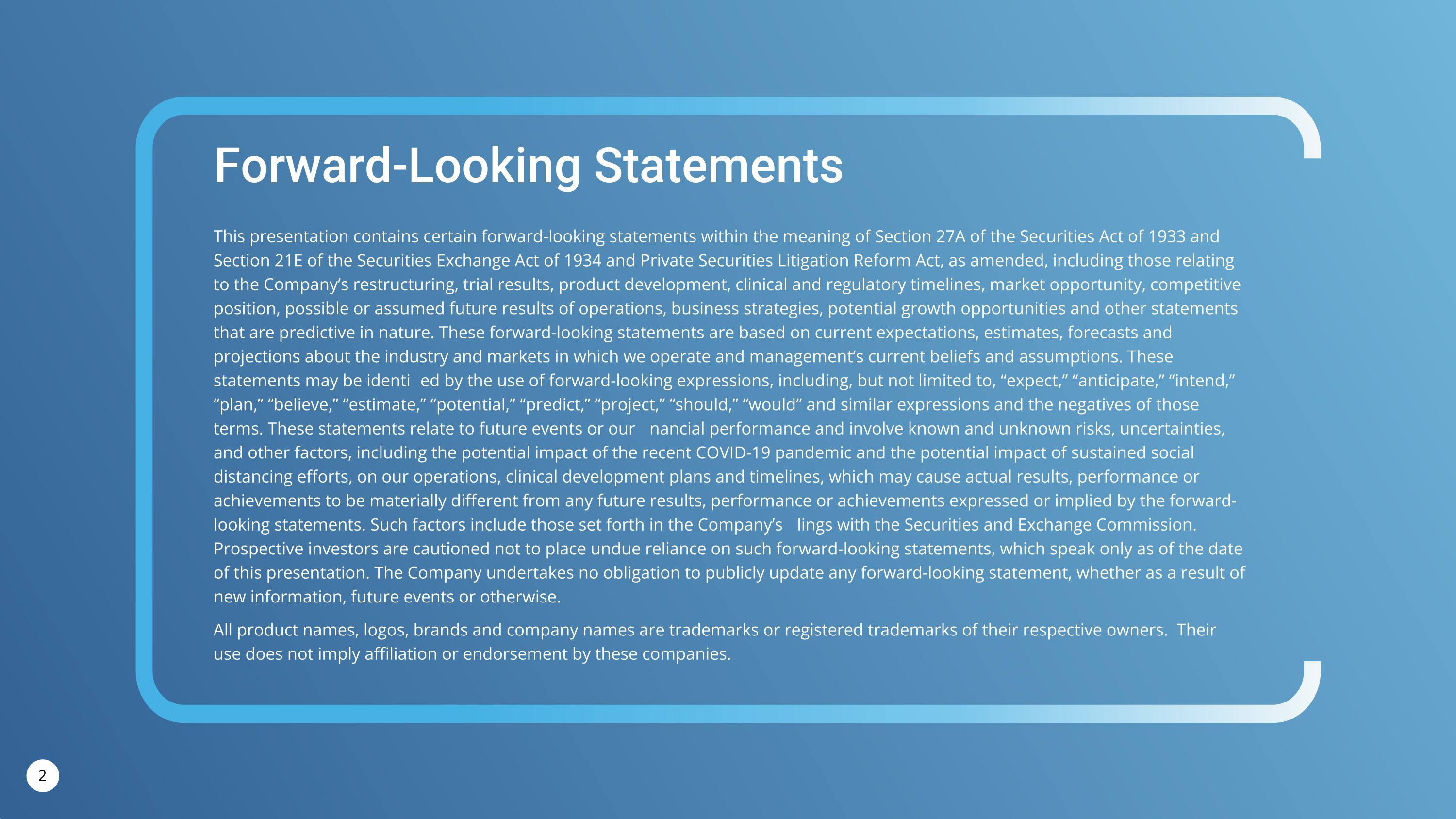
Forward-Looking Statements This presentation contains certain forward-looking statements within the meaning of Section 27A of the Securities Act of 1933 and Section 21E of the Securities Exchange Act of 1934 and Private Securities Litigation Reform Act, as amended, including those relating to the Company’s restructuring, trial results, product development, clinical and regulatory timelines, market opportunity, competitive position, possible or assumed future results of operations, business strategies, potential growth opportunities and other statements that are predictive in nature. These forward-looking statements are based on current expectations, estimates, forecasts and projections about the industry and markets in which we operate and management’s current beliefs and assumptions. These statements may be identified by the use of forward-looking expressions, including, but not limited to, “expect,” “anticipate,” “intend,” “plan,” “believe,” “estimate,” “potential,” “predict,” “project,” “should,” “would” and similar expressions and the negatives of those terms. These statements relate to future events or our financial performance and involve known and unknown risks, uncertainties, and other factors, including the potential impact of the recent COVID-19 pandemic and the potential impact of sustained social distancing efforts, on our operations, clinical development plans and timelines, which may cause actual results, performance or achievements to be materially different from any future results, performance or achievements expressed or implied by the forward-looking statements. Such factors include those set forth in the Company’s filings with the Securities and Exchange Commission. Prospective investors are cautioned not to place undue reliance on such forward-looking statements, which speak only as of the date of this presentation. The Company undertakes no obligation to publicly update any forward-looking statement, whether as a result of new information, future events or otherwise. All product names, logos, brands and company names are trademarks or registered trademarks of their respective owners. Their use does not imply affiliation or endorsement by these companies.
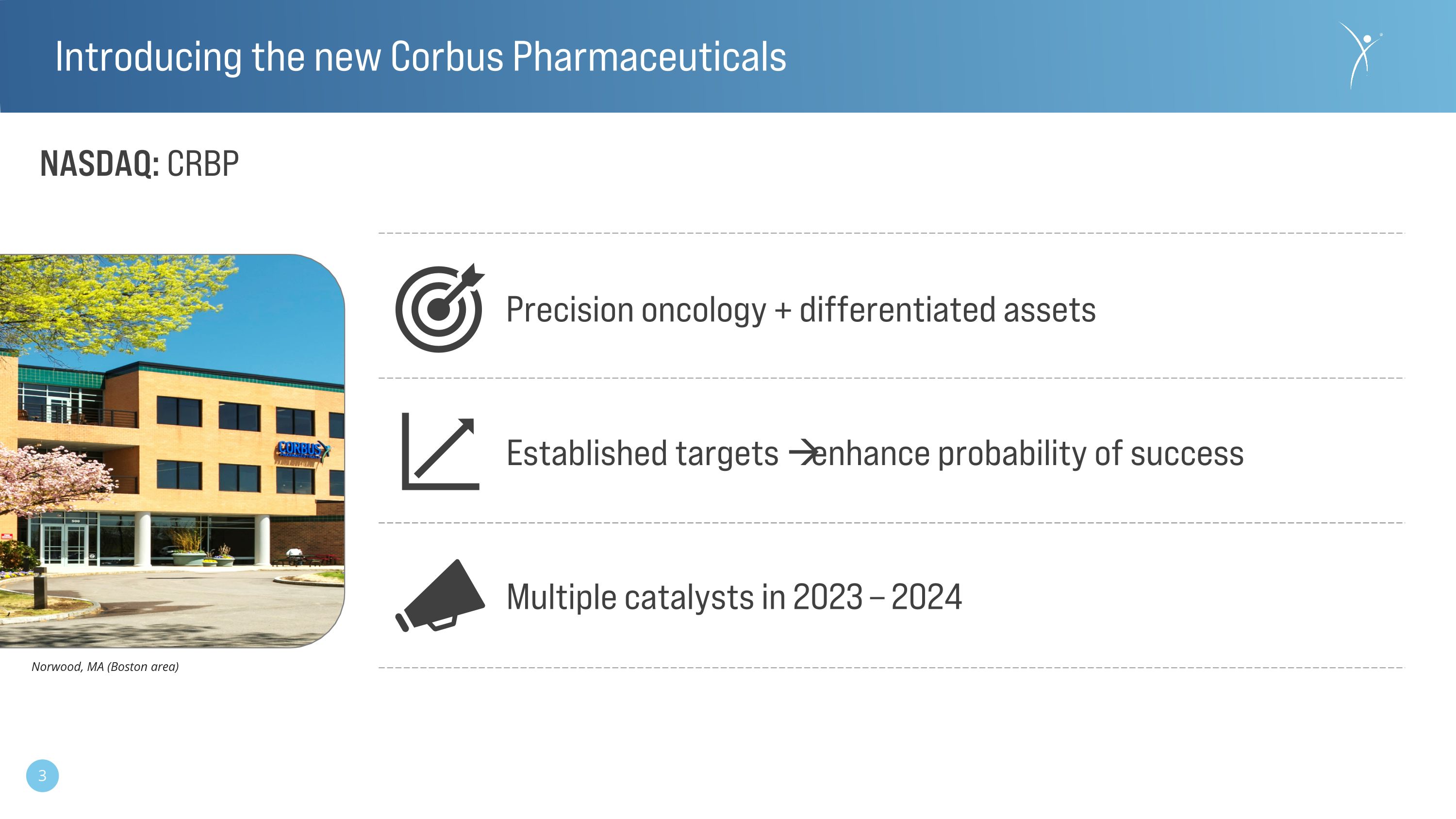
Introducing the new Corbus Pharmaceuticals Norwood, MA (Boston area) NASDAQ: CRBP Precision oncology + differentiated assets Established targets enhance probability of success Multiple catalysts in 2023 – 2024
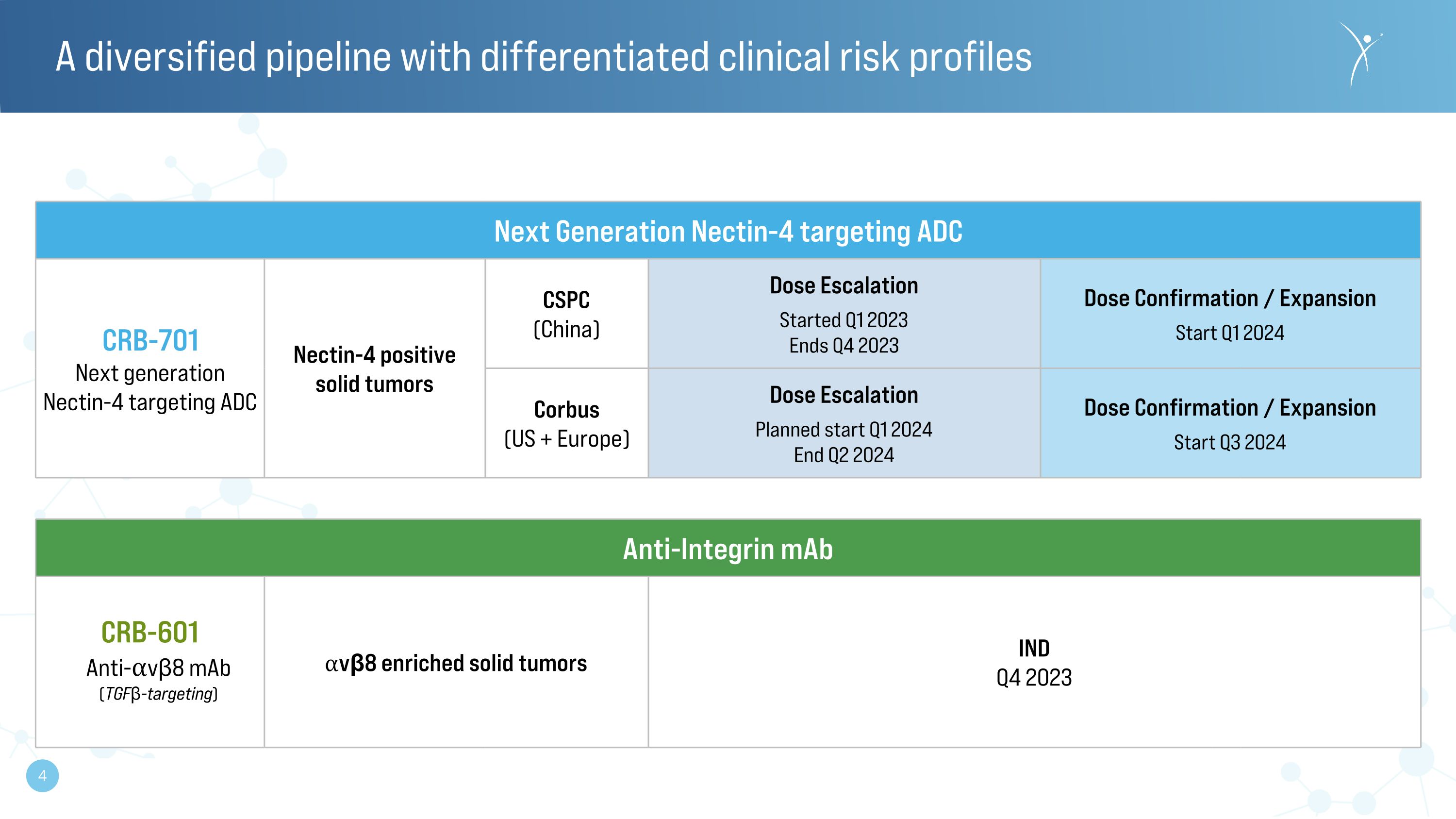
Next Generation Nectin-4 targeting ADC CRB-701 Next generation Nectin-4 targeting ADC Nectin-4 positive solid tumors CSPC (China) Dose Escalation Started Q1 2023 Ends Q4 2023 Dose Confirmation / Expansion Start Q1 2024 Dose Confirmation / Expansion Start Q1 2024 Corbus (US + Europe) Dose Escalation Planned start Q1 2024 End Q2 2024 Dose Confirmation / Expansion Start Q3 2024 Dose Confirmation / Expansion Start Q3 2024 Dose Confirmation Anti-Integrin mAb CRB-601 Anti-⍺vβ8 mAb (TGFβ-targeting) ⍺vβ8 enriched solid tumors IND Q4 2023 A diversified pipeline with differentiated clinical risk profiles
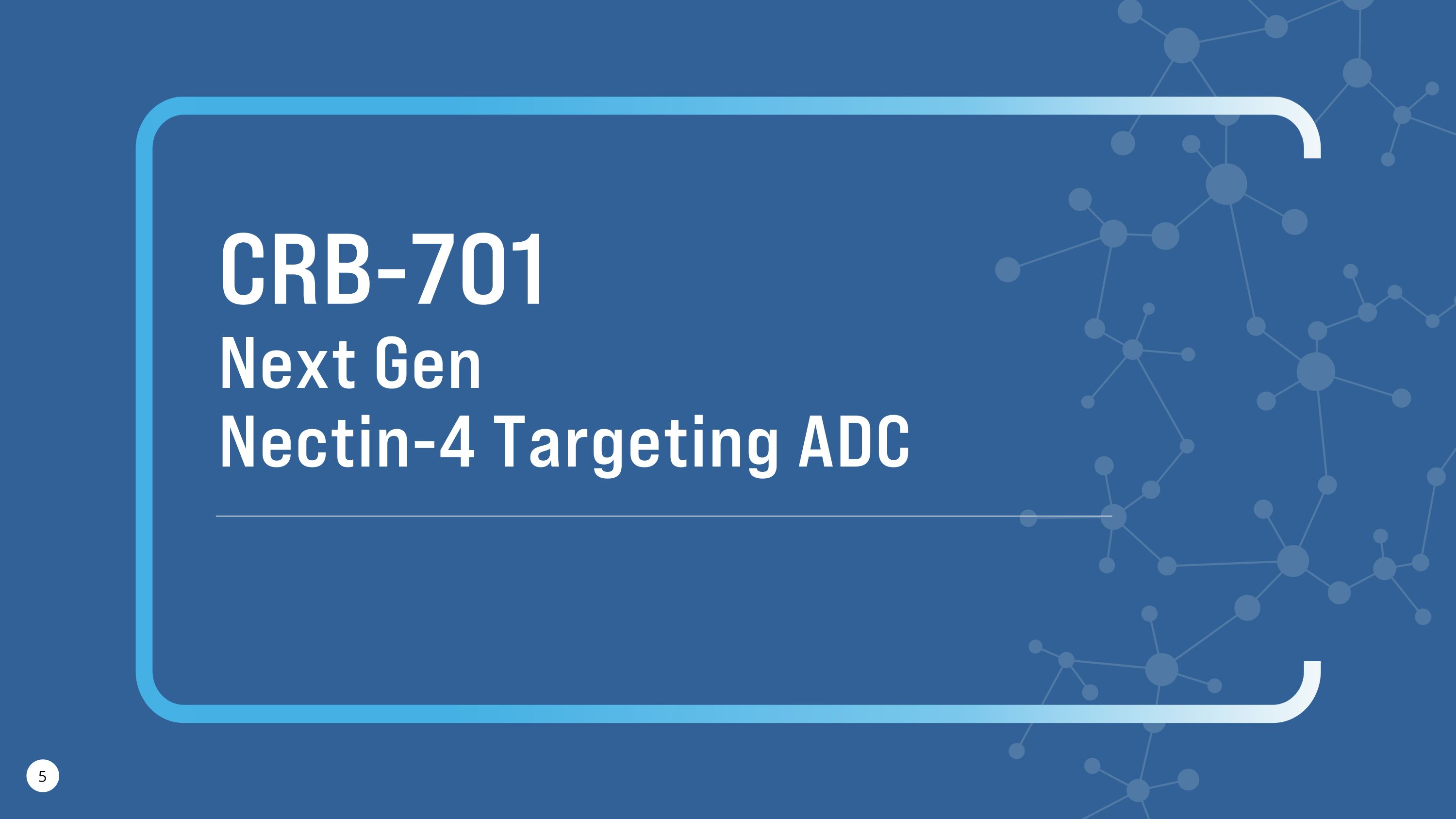
CRB-701 Next Gen Nectin-4 Targeting ADC

CRB-701: Key clinical updates Clinical Progress Clinical Data Current China Phase 1 escalation is ahead of schedule (ends Q4 2023) CRB-701: 1.2 mg/kg (Q3W/21 days) vs. PADCEV®: 1.25 mg/kg (Q1Wx3/28 days) ADC AUC is comparable CRB-701 is currently dosing above PADCEV®’s RP2D of 1.25 mg/kg Marked reduction in levels of circulating free MMAE compared to PADCEV® 1.2 mg/kg Source(s): Corbus data on file; PADCEV® Prescribing Information as of Dec 2019
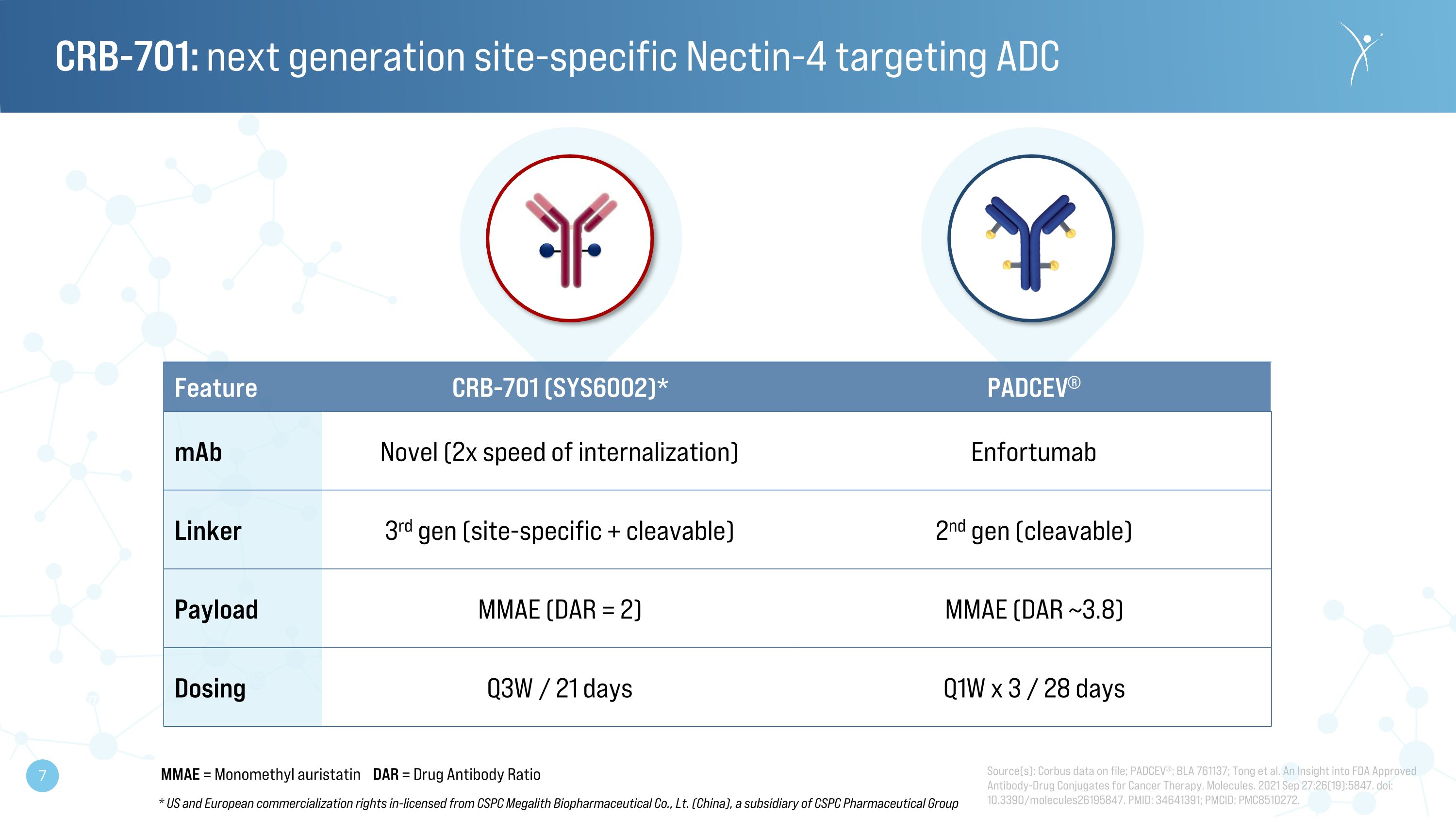
CRB-701: next generation site-specific Nectin-4 targeting ADC MMAE = Monomethyl auristatin E ADCC = antibody-dependent cellular cytotoxicity CDC = complement dependent cytotoxicity DAR = Drug Antibody Ratio Source(s): Corbus data on file; PADCEV®; BLA 761137; Tong et al. An Insight into FDA Approved Antibody-Drug Conjugates for Cancer Therapy. Molecules. 2021 Sep 27;26(19):5847. doi: 10.3390/molecules26195847. PMID: 34641391; PMCID: PMC8510272. US and European commercialization rights in-licensed from CSPC Megalith Biopharmaceutical Co., Lt. (China), a subsidiary of CSPC Pharmaceutical Group Feature CRB-701 (SYS6002)* PADCEV® mAb Novel (2x speed of internalization) Enfortumab Linker 3rd gen (site-specific + cleavable) 2nd gen (cleavable) Payload MMAE (DAR = 2) MMAE (DAR ~3.8) Dosing Q3W / 21 days Q1W x 3 / 28 days * US and European commercialization rights in-licensed from CSPC Megalith Biopharmaceutical Co., Lt. (China), a subsidiary of CSPC Pharmaceutical Group MMAE = Monomethyl auristatin DAR = Drug Antibody Ratio
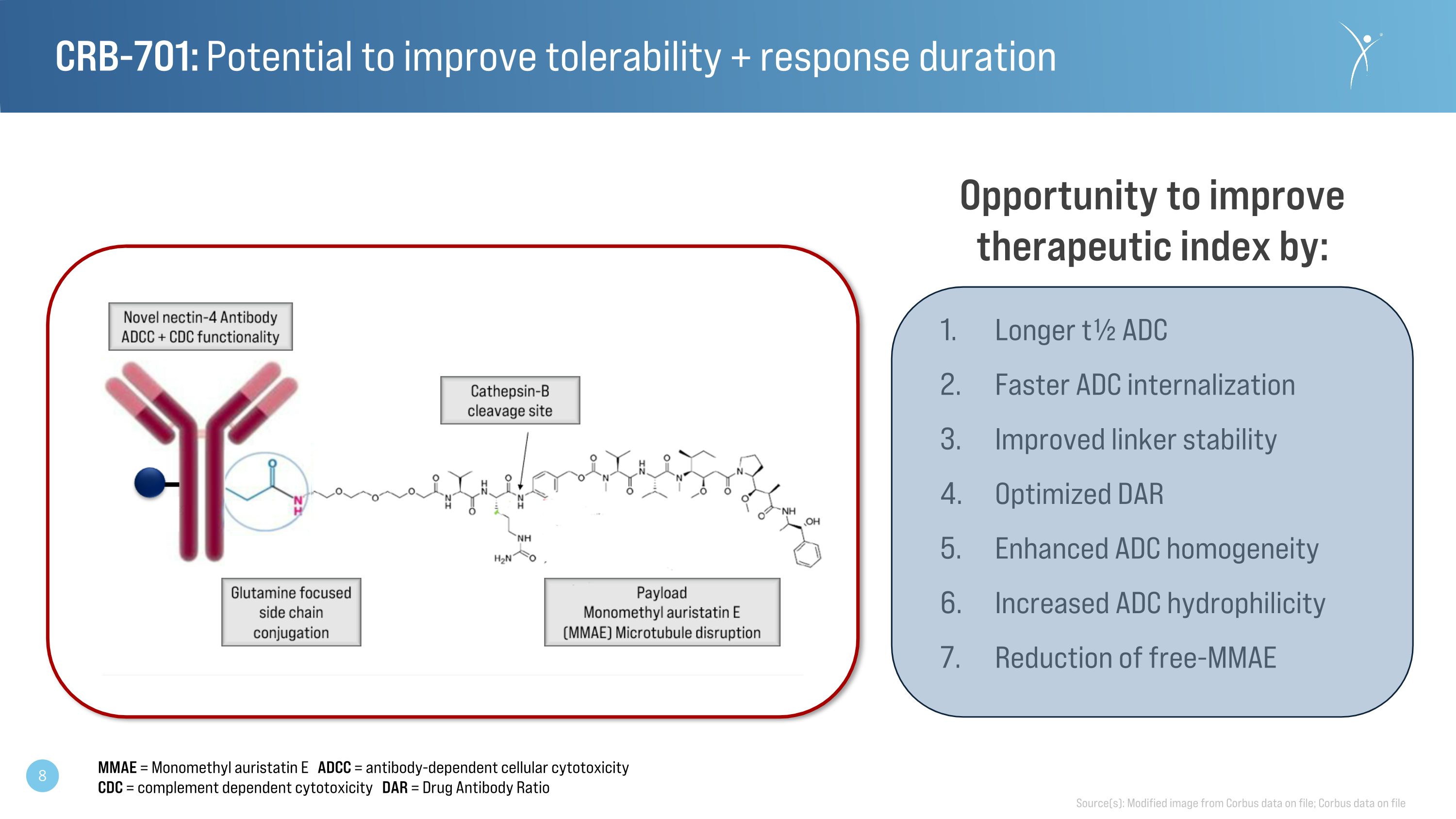
CRB-701: Potential to improve tolerability + response duration Source(s): Modified image from Corbus data on file; Corbus data on file Longer t½ ADC Faster ADC internalization Improved linker stability Optimized DAR Enhanced ADC homogeneity Increased ADC hydrophilicity Reduction of free-MMAE Opportunity to improve therapeutic index by: MMAE = Monomethyl auristatin E ADCC = antibody-dependent cellular cytotoxicity CDC = complement dependent cytotoxicity DAR = Drug Antibody Ratio
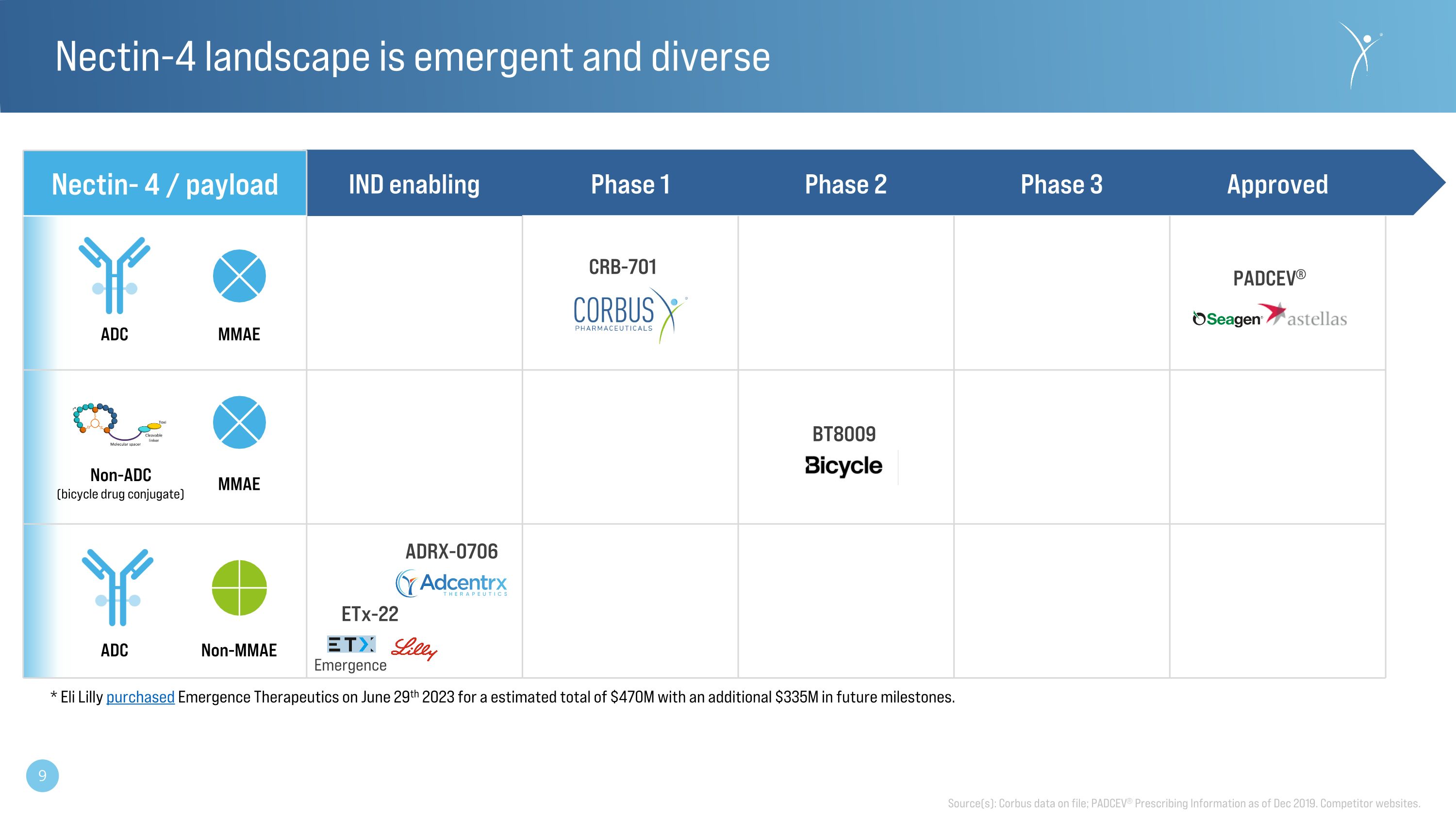
Nectin- 4 / payload IND enabling Phase 1 Phase 2 Phase 3 Approved Nectin-4 landscape is emergent and diverse ADC Non-ADC (bicycle drug conjugate) MMAE ADC Non-MMAE * Eli Lilly purchased Emergence Therapeutics on June 29th 2023 for a estimated total of $470M with an additional $335M in future milestones. MMAE CRB-701 Emergence ETx-22 ADRX-0706 BT8009 PADCEV® Source(s): Corbus data on file; PADCEV® Prescribing Information as of Dec 2019. Competitor websites.
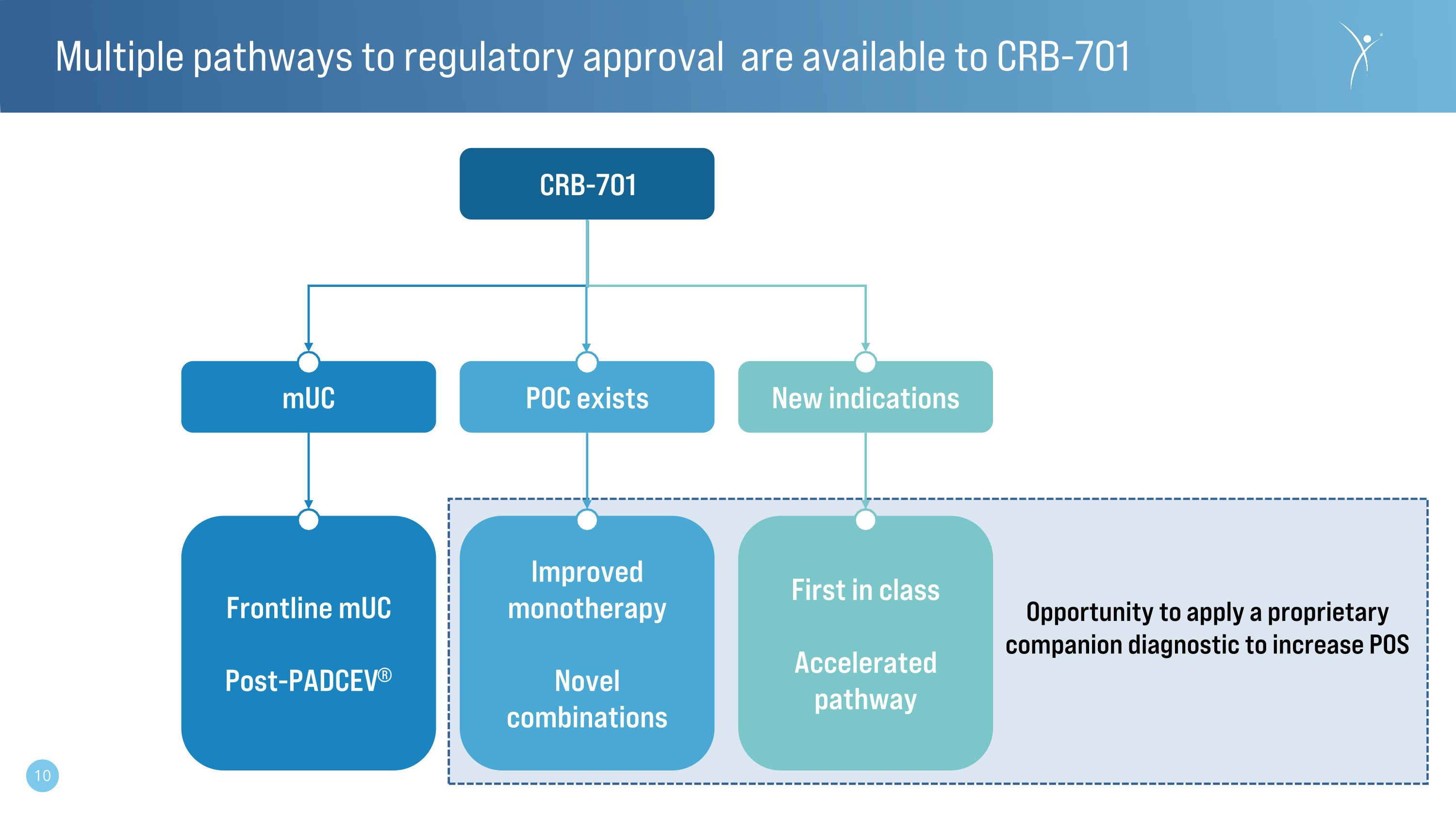
Multiple pathways to regulatory approval are available to CRB-701 CRB-701 mUC POC exists New indications Frontline mUC Post-PADCEV® Improved monotherapy Novel combinations First in class Accelerated pathway Opportunity to apply a proprietary companion diagnostic to increase POS

CRB-701: Once in 21 days schedule offers significant advantages The current dosing schedule suggests 3 doses of PADCEV® compared to 1 dose CRB-701 PADCEV® CRB-701 Patient / physician convenience Combination flexibility Clinical cycle comparison Source(s): Corbus data on file; PADCEV® Prescribing Information as of Dec 2019
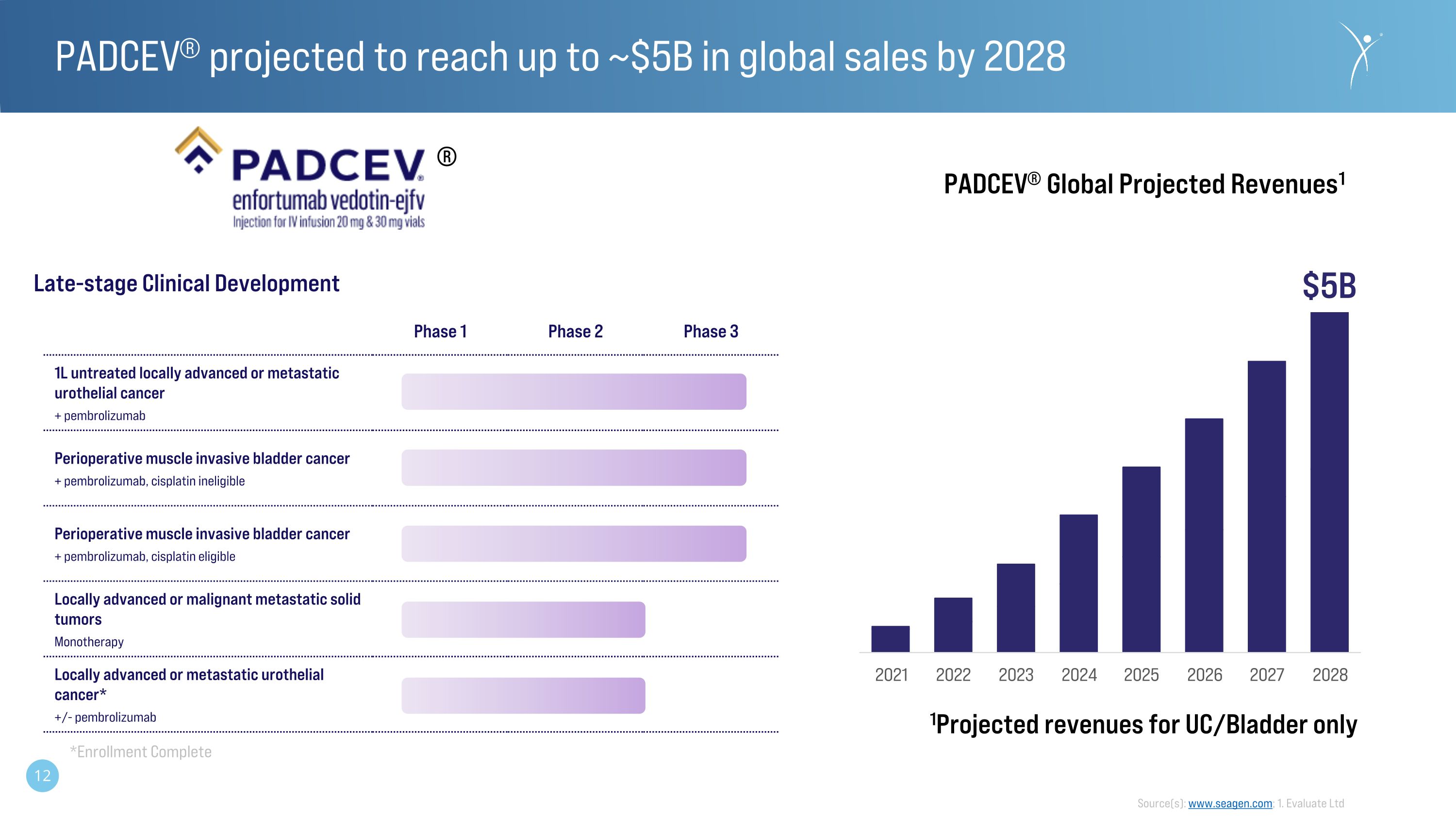
PADCEV® projected to reach up to ~$5B in global sales by 2028 Late-stage Clinical Development $5B 1Projected revenues for UC/Bladder only ® Phase 1 Phase 2 Phase 3 1L untreated locally advanced or metastatic urothelial cancer + pembrolizumab Perioperative muscle invasive bladder cancer + pembrolizumab, cisplatin ineligible Perioperative muscle invasive bladder cancer + pembrolizumab, cisplatin eligible Locally advanced or malignant metastatic solid tumors Monotherapy Locally advanced or metastatic urothelial cancer* +/- pembrolizumab *Enrollment Complete Source(s): www.seagen.com; 1. Evaluate Ltd
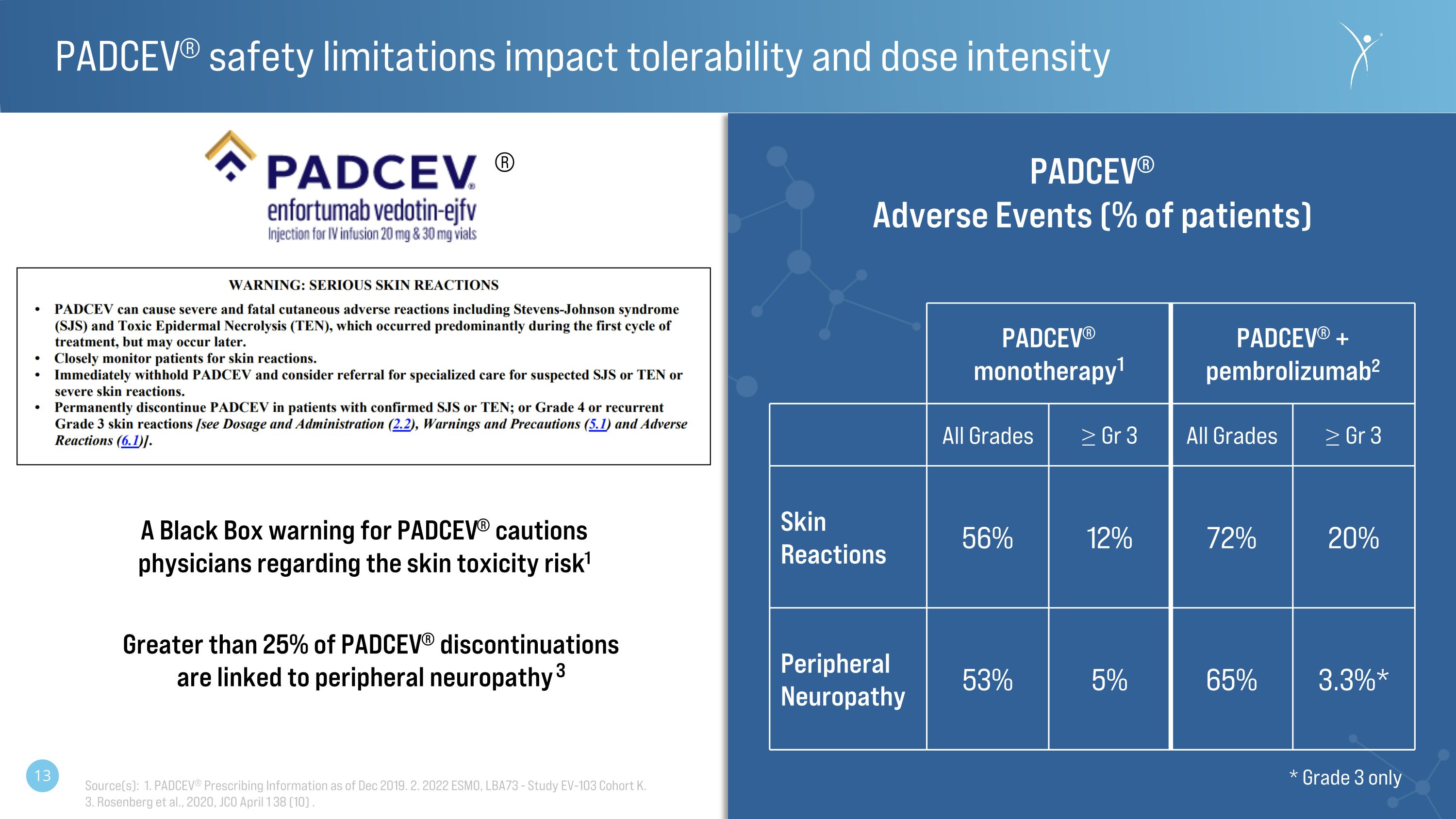
PADCEV® safety limitations impact tolerability and dose intensity PADCEV® monotherapy1 PADCEV® + pembrolizumab2 All Grades ≥ Gr 3 All Grades ≥ Gr 3 Skin Reactions 56% 12% 72% 20% Peripheral Neuropathy 53% 5% 65% 3.3%* PADCEV® Adverse Events (% of patients) Source(s): 1. PADCEV® Prescribing Information as of Dec 2019. 2. 2022 ESMO, LBA73 - Study EV-103 Cohort K. 3. Rosenberg et al., 2020, JCO April 1 38 (10) . Greater than 25% of PADCEV® discontinuations are linked to peripheral neuropathy 3 ® * Grade 3 only A Black Box warning for PADCEV® cautions physicians regarding the skin toxicity risk1
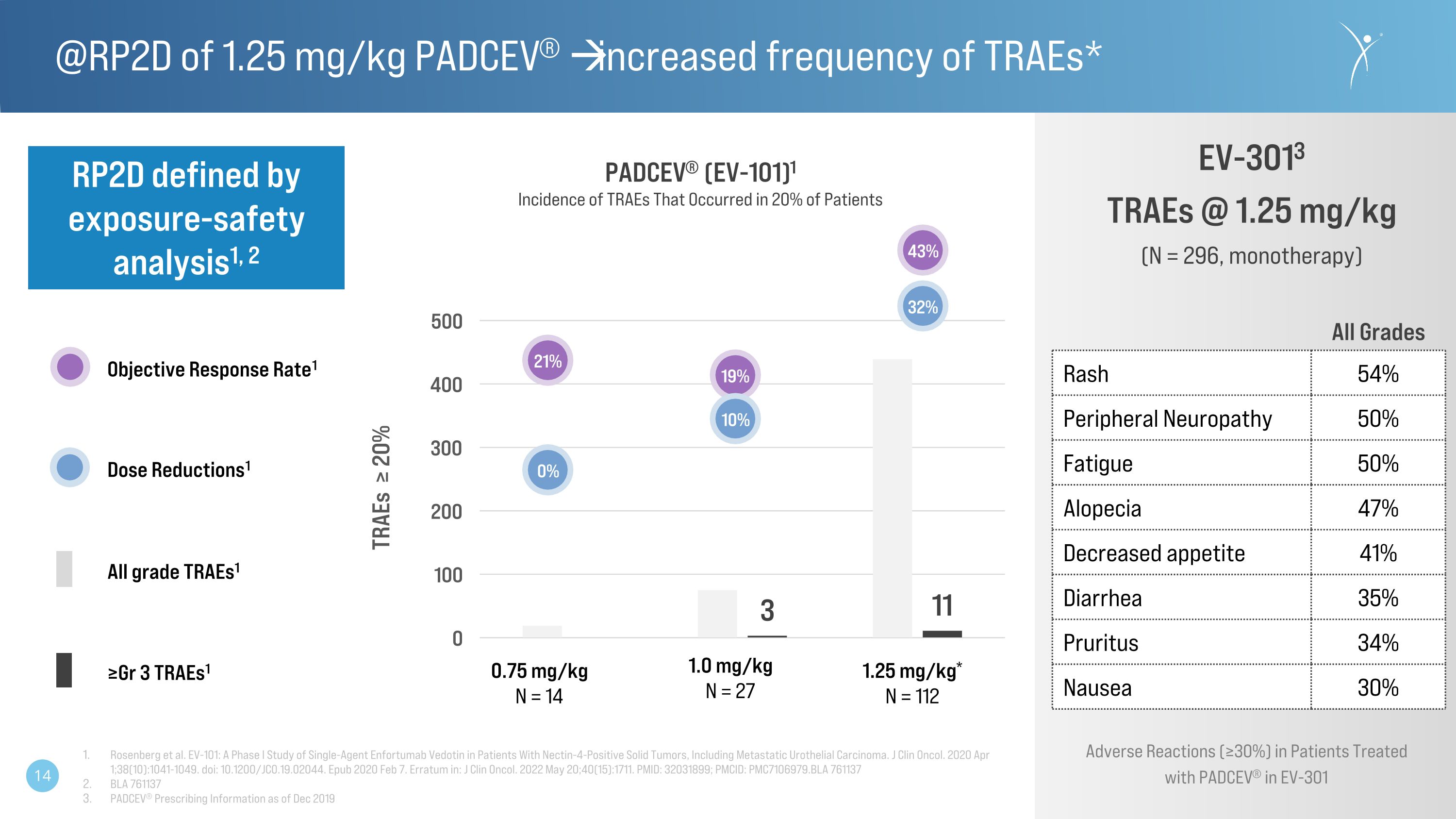
PADCEV® (EV-101)1 Incidence of TRAEs That Occurred in 20% of Patients Adverse Reactions (≥30%) in Patients Treated with PADCEV® in EV-301 0.75 mg/kg N = 14 1.0 mg/kg N = 27 1.25 mg/kg* N = 112 @RP2D of 1.25 mg/kg PADCEV® increased frequency of TRAEs* Objective Response Rate1 All grade TRAEs1 ≥Gr 3 TRAEs1 EV-3013 TRAEs @ 1.25 mg/kg (N = 296, monotherapy) All Grades Rosenberg et al. EV-101: A Phase I Study of Single-Agent Enfortumab Vedotin in Patients With Nectin-4-Positive Solid Tumors, Including Metastatic Urothelial Carcinoma. J Clin Oncol. 2020 Apr 1;38(10):1041-1049. doi: 10.1200/JCO.19.02044. Epub 2020 Feb 7. Erratum in: J Clin Oncol. 2022 May 20;40(15):1711. PMID: 32031899; PMCID: PMC7106979.BLA 761137 BLA 761137 PADCEV® Prescribing Information as of Dec 2019 RP2D defined by exposure-safety analysis1, 2 Dose Reductions1 Rash 54% Peripheral Neuropathy 50% Fatigue 50% Alopecia 47% Decreased appetite 41% Diarrhea 35% Pruritus 34% Nausea 30%
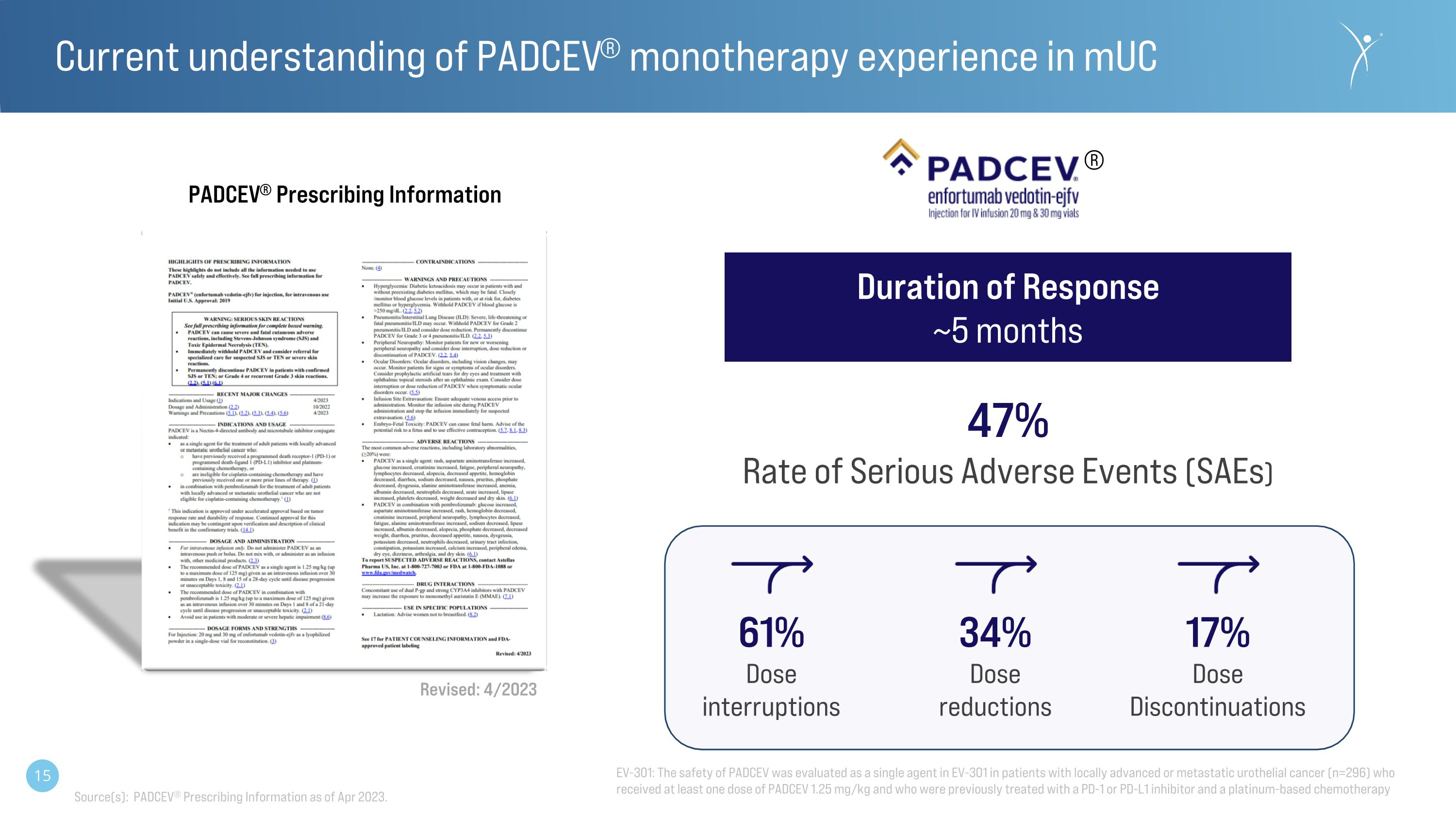
Current understanding of PADCEV® monotherapy experience in mUC ® Duration of Response ~5 months 47% Rate of Serious Adverse Events (SAEs) 61% Dose interruptions 34% Dose reductions 17% Dose Discontinuations Revised: 4/2023 PADCEV® Prescribing Information Source(s): PADCEV® Prescribing Information as of Apr 2023. EV-301: The safety of PADCEV was evaluated as a single agent in EV-301 in patients with locally advanced or metastatic urothelial cancer (n=296) who received at least one dose of PADCEV 1.25 mg/kg and who were previously treated with a PD-1 or PD-L1 inhibitor and a platinum-based chemotherapy

CRB-701: equivalent pre-clinical efficacy in a DAR 2 vs. DAR 4 ADC-MMAE Comparison of in-vivo pharmacology Prostate Cancer Triple Negative Breast Cancer P *** 0.001; ** 0.01; * 0.1 If improved therapeutic index is demonstrated clinically then the potential to see both a higher dose & greater efficacy exists ** ** *** *** *** *** CRB-701 in PC-3 – Nectin-4 (Nectin-4 overexpression) CRB-701 in MDA-MB-468 (Nectin-4 low/mid) SOC SOC Source(s): Corbus data on file
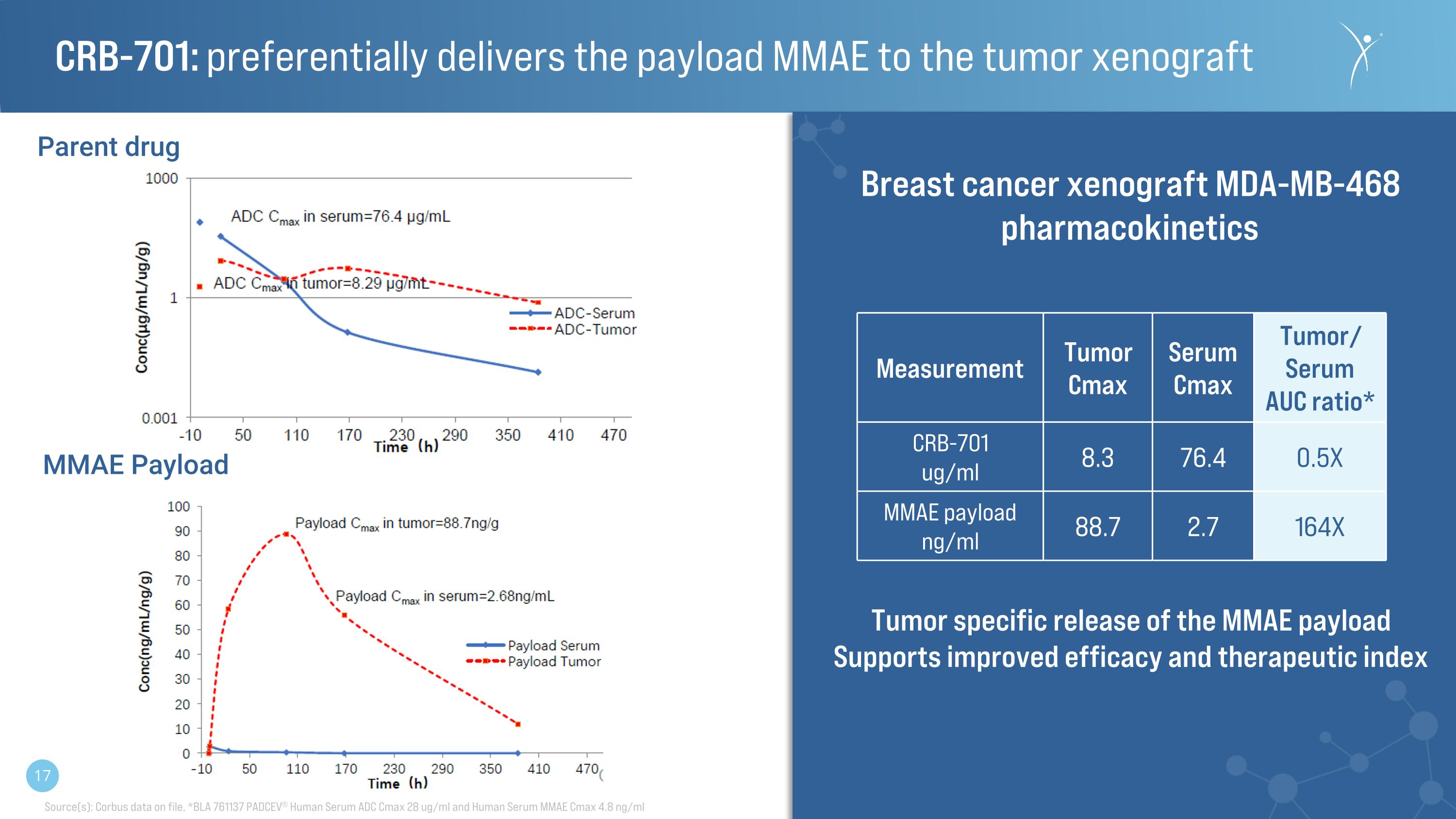
CRB-701: preferentially delivers the payload MMAE to the tumor xenograft Breast cancer xenograft MDA-MB-468 pharmacokinetics Tumor specific release of the MMAE payload Supports improved efficacy and therapeutic index Measurement Tumor Cmax Serum Cmax Tumor/ Serum AUC ratio* CRB-701 ug/ml 8.3 76.4 0.5X MMAE payload ng/ml 88.7 2.7 164X Parent drug MMAE Payload Source(s): Corbus data on file, *BLA 761137 PADCEV® Human Serum ADC Cmax 28 ug/ml and Human Serum MMAE Cmax 4.8 ng/ml
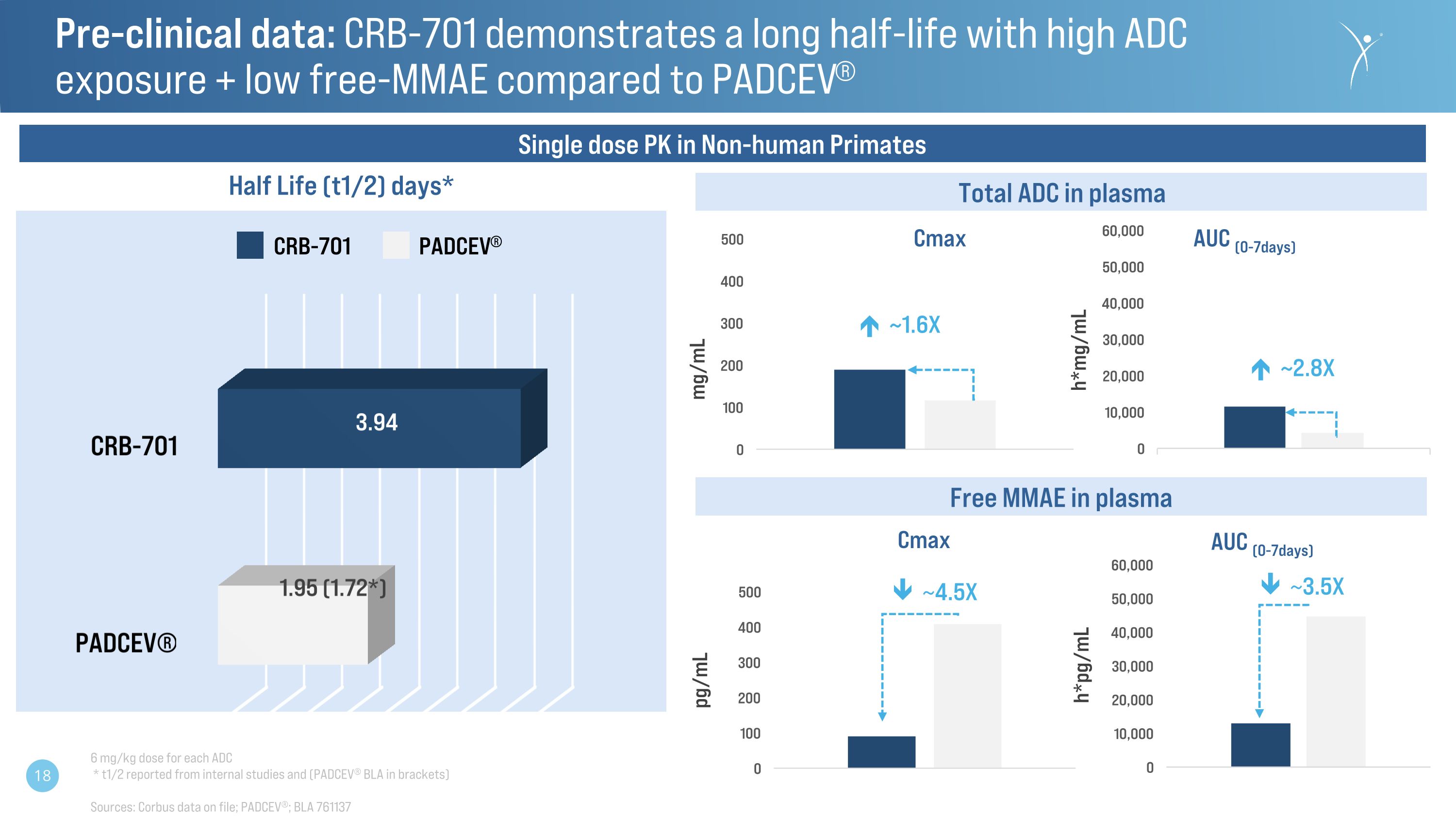
Half Life (t1/2) days* Total ADC in plasma Single dose PK in Non-human Primates ~2.8X ~4.5X ~3.5X Cmax ~1.6X mg/mL h*mg/mL pg/mL h*pg/mL AUC (0-7days) AUC Pre-clinical data: CRB-701 demonstrates a long half-life with high ADC exposure + low free-MMAE compared to PADCEV® CRB-701 PADCEV® 6 mg/kg dose for each ADC * t1/2 reported from internal studies and (PADCEV® BLA in brackets) Sources: Corbus data on file; PADCEV®; BLA 761137 AUC (0-7days) Free MMAE in plasma Cmax
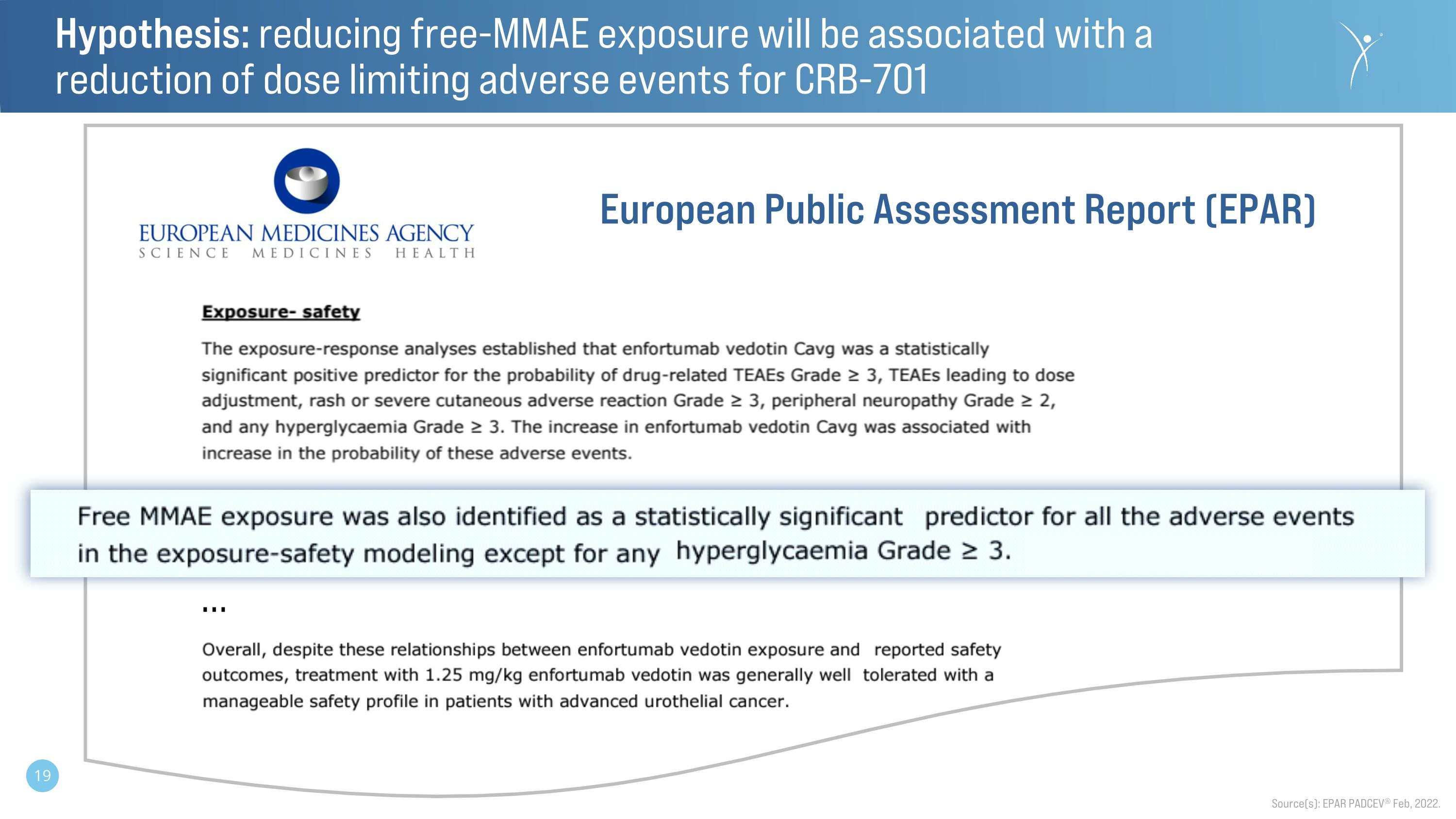
Hypothesis: reducing free-MMAE exposure will be associated with a reduction of dose limiting adverse events for CRB-701 Source(s): EPAR PADCEV® Feb, 2022. European Public Assessment Report (EPAR) …
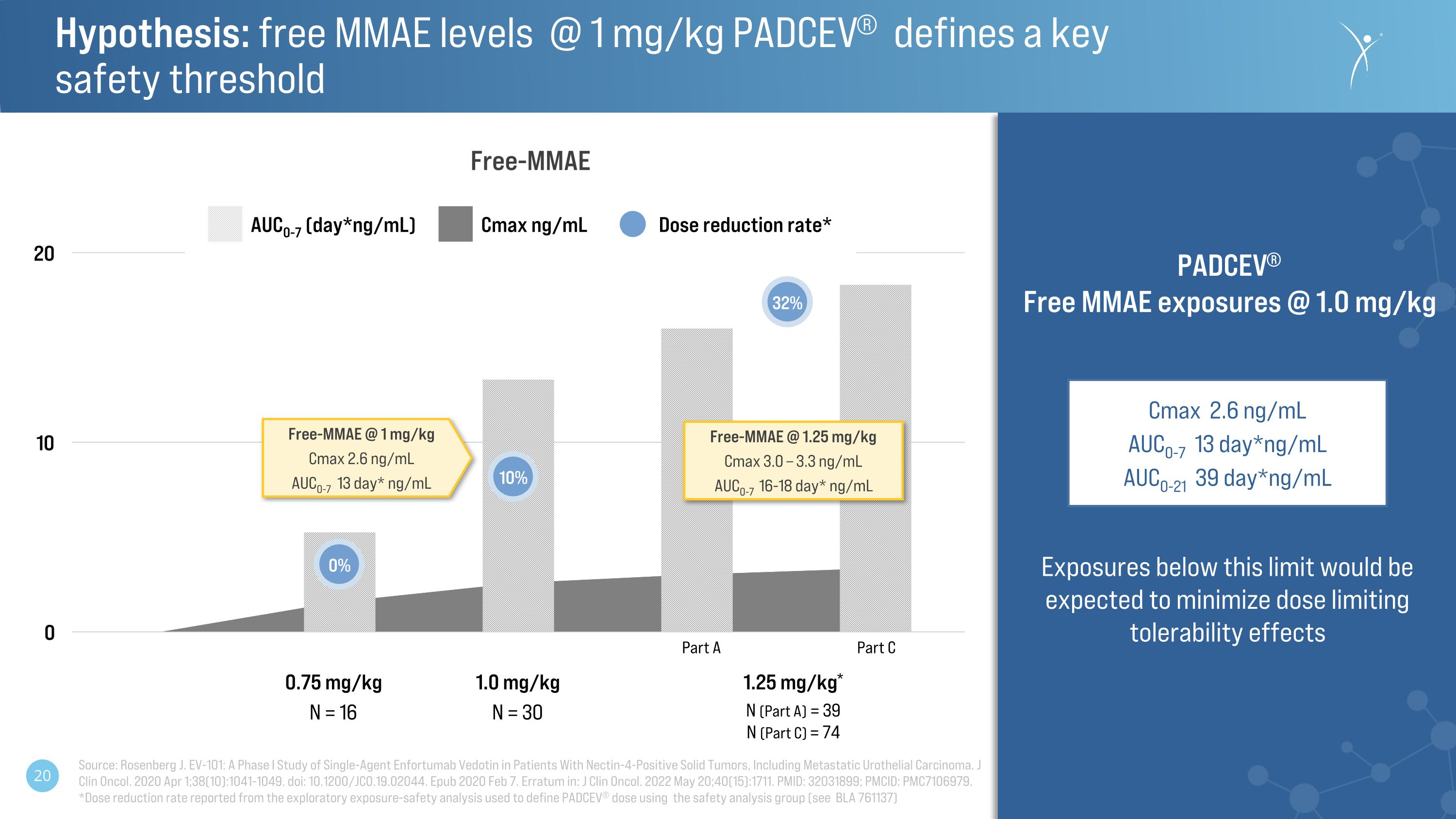
Hypothesis: free MMAE levels @ 1 mg/kg PADCEV® defines a key safety threshold Free-MMAE Source: Rosenberg J. EV-101: A Phase I Study of Single-Agent Enfortumab Vedotin in Patients With Nectin-4-Positive Solid Tumors, Including Metastatic Urothelial Carcinoma. J Clin Oncol. 2020 Apr 1;38(10):1041-1049. doi: 10.1200/JCO.19.02044. Epub 2020 Feb 7. Erratum in: J Clin Oncol. 2022 May 20;40(15):1711. PMID: 32031899; PMCID: PMC7106979. *Dose reduction rate reported from the exploratory exposure-safety analysis used to define PADCEV® dose using the safety analysis group (see BLA 761137) 0.75 mg/kg N = 16 1.0 mg/kg N = 30 1.25 mg/kg* N (Part A) = 39 N (Part C) = 74 Part A Part C Cmax ng/mL Dose reduction rate* AUC0-7 (day*ng/mL) Free-MMAE @ 1 mg/kg Cmax 2.6 ng/mL AUC0-7 13 day* ng/mL Free-MMAE @ 1.25 mg/kg Cmax 3.0 – 3.3 ng/mL AUC0-7 16-18 day* ng/mL Exposures below this limit would be expected to minimize dose limiting tolerability effects Cmax 2.6 ng/mL AUC0-7 13 day*ng/mL AUC0-21 39 day*ng/mL PADCEV® Free MMAE exposures @ 1.0 mg/kg
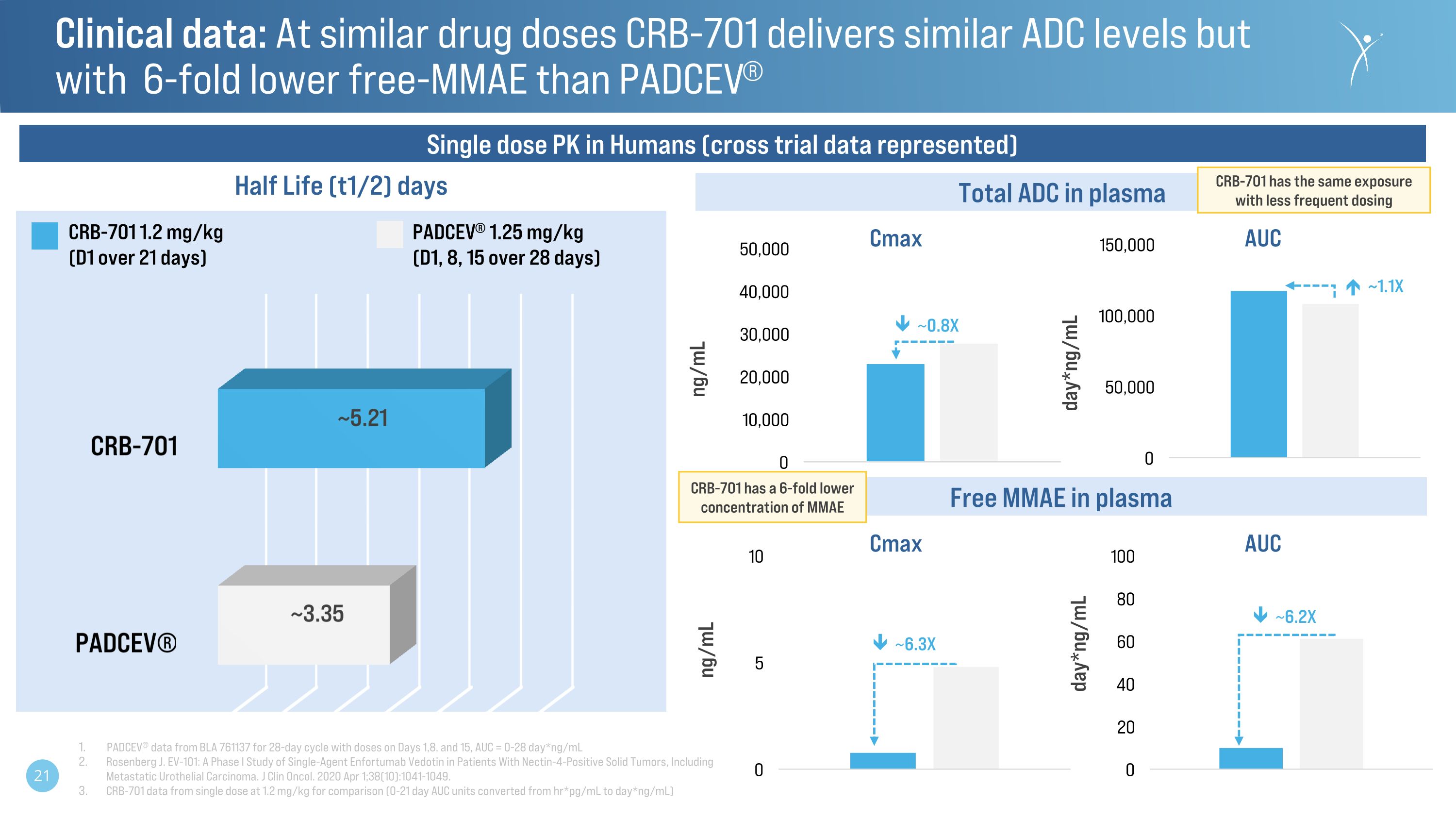
Half Life (t1/2) days Total ADC in plasma Single dose PK in Humans (cross trial data represented) Cmax ng/mL day*ng/mL AUC Clinical data: At similar drug doses CRB-701 delivers similar ADC levels but with 6-fold lower free-MMAE than PADCEV® CRB-701 1.2 mg/kg (D1 over 21 days) PADCEV® 1.25 mg/kg (D1, 8, 15 over 28 days) Free MMAE in plasma PADCEV® data from BLA 761137 for 28-day cycle with doses on Days 1,8, and 15, AUC = 0-28 day*ng/mL Rosenberg J. EV-101: A Phase I Study of Single-Agent Enfortumab Vedotin in Patients With Nectin-4-Positive Solid Tumors, Including Metastatic Urothelial Carcinoma. J Clin Oncol. 2020 Apr 1;38(10):1041-1049. CRB-701 data from single dose at 1.2 mg/kg for comparison (0-21 day AUC units converted from hr*pg/mL to day*ng/mL) ng/mL day*ng/mL Cmax AUC ~1.1X ~6.3X ~6.2X ~0.8X CRB-701 has the same exposure with less frequent dosing CRB-701 has a 6-fold lower concentration of MMAE
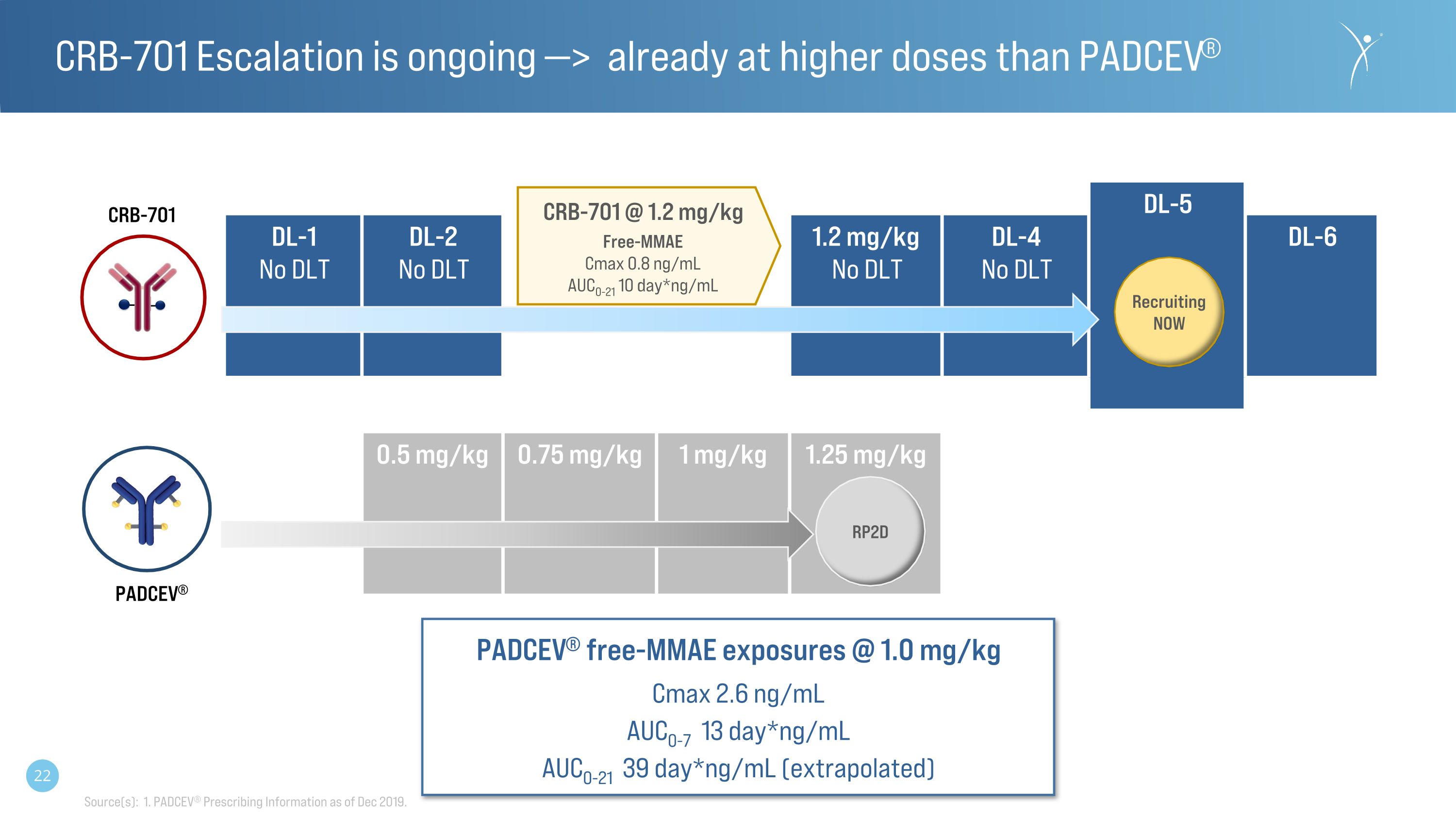
CRB-701 Escalation is ongoing —> already at higher doses than PADCEV® 22 DL-5 DL-1 No DLT DL-2 No DLT 1.2 mg/kg No DLT DL-4 No DLT DL-6 0.5 mg/kg 0.75 mg/kg 1 mg/kg 1.25 mg/kg Recruiting NOW RP2D CRB-701 PADCEV® PADCEV® free-MMAE exposures @ 1.0 mg/kg Cmax 2.6 ng/mL AUC0-7 13 day*ng/mL AUC0-21 39 day*ng/mL (extrapolated) CRB-701 @ 1.2 mg/kg Free-MMAE Cmax 0.8 ng/mL AUC0-21 10 day*ng/mL Source(s): 1. PADCEV® Prescribing Information as of Dec 2019.

Validation of Nectin-4 as a tumor associated antigen beyond mUC Parameter Patients (N=46) Confirmed ORR 11 (23.9%) CR 1 (2.2%) PR 10 (21.7%) SD 15 (32.6%) mPFS 3.94 months Source: Corbus data on file, Swiecicki et al., Abstract 6017., ASCO 2023 Elevated Nectin-4 expression: urothelial, breast, ovarian, cervical, colorectal, rectal, esophageal, gastric, lung, thyroid, prostate, cholangiocarcinoma, pancreatic cancer, testicular cancer <---- Other highly expressing tumors ----> UC H&NSCC H&NSCC
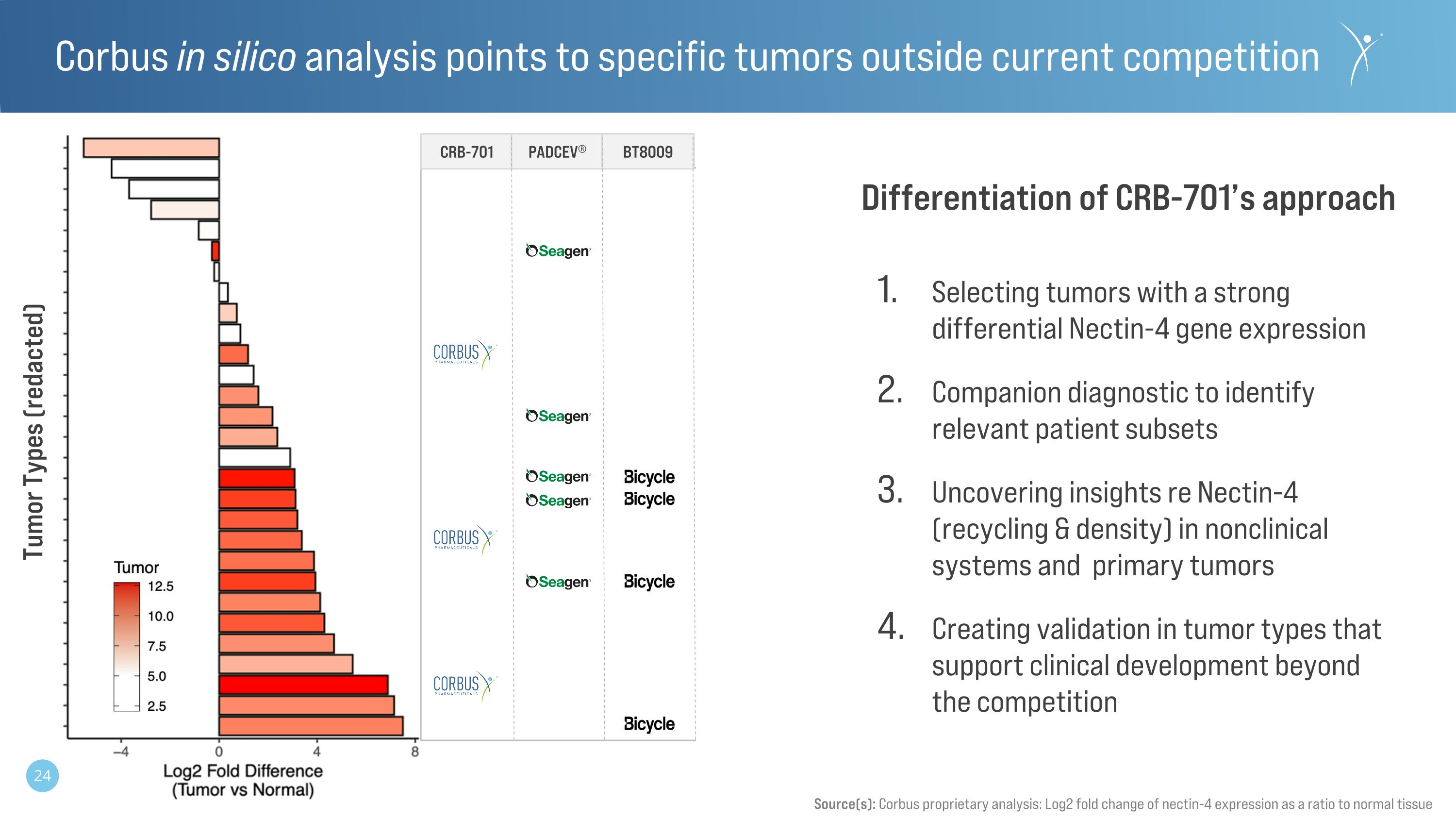
Corbus in silico analysis points to specific tumors outside current competition Source(s): Corbus proprietary analysis: Log2 fold change of nectin-4 expression as a ratio to normal tissue Differentiation of CRB-701’s approach Selecting tumors with a strong differential Nectin-4 gene expression Companion diagnostic to identify relevant patient subsets Uncovering insights re Nectin-4 (recycling & density) in nonclinical systems and primary tumors Creating validation in tumor types that support clinical development beyond the competition Tumor Types (redacted) CRB-701 PADCEV® BT8009
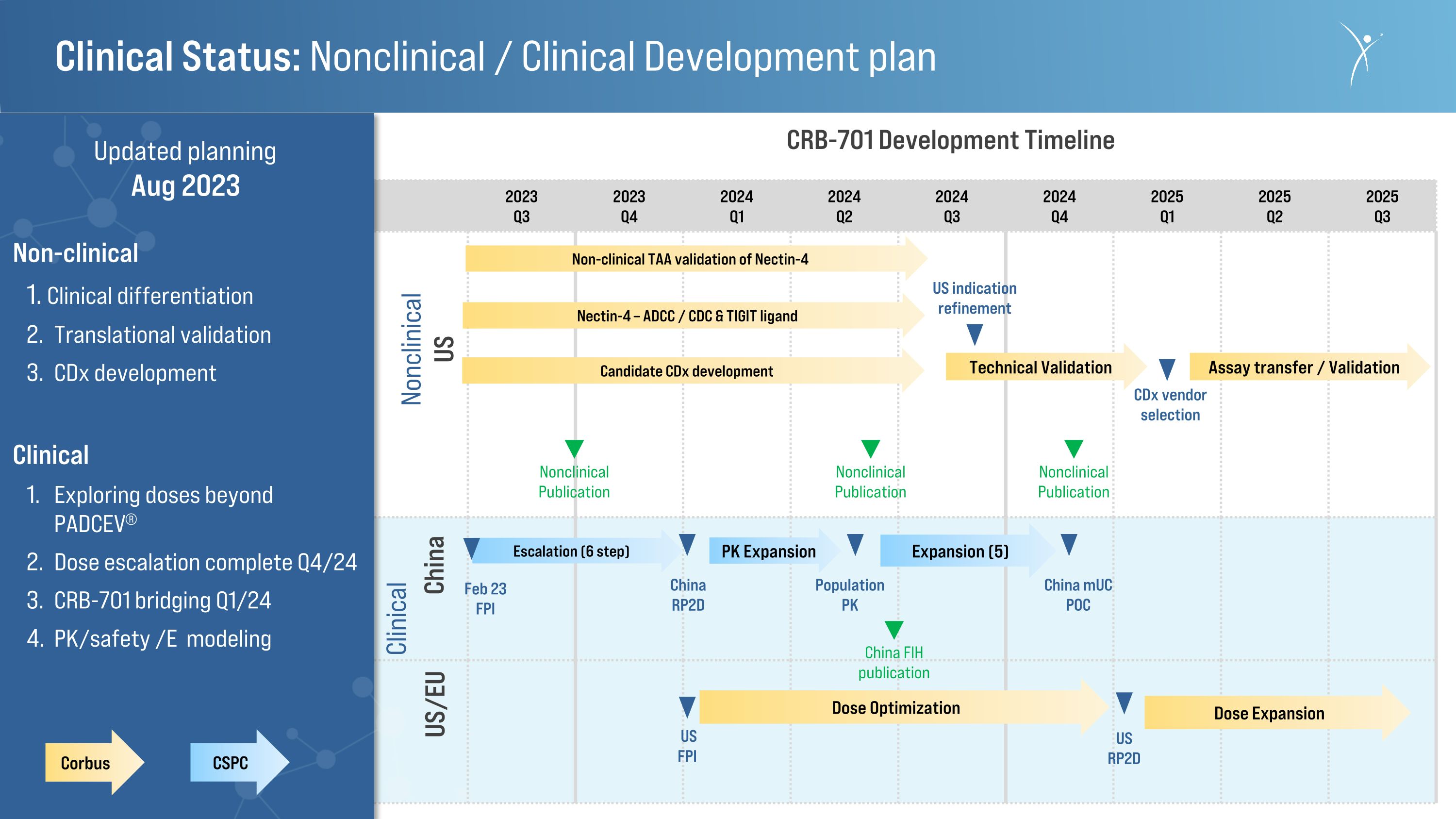
Clinical Status: Nonclinical / Clinical Development plan 2023 Q1 2023 Q2 2023 Q3 2023 Q4 2024 Q1 2024 Q2 2024 Q3 2024 Q4 2025 Q1 2025 Q2 2025 Q3 CRB-701 Development Timeline China US/EU Non-clinical TAA validation of Nectin-4 US RP2D Escalation (6 step) Nectin-4 – ADCC / CDC & TIGIT ligand Nonclinical US CDx vendor selection Expansion (5) Feb 23 FPI Population PK China RP2D China mUC POC Assay transfer / Validation Nonclinical Publication US indication refinement Corbus CSPC Dose Optimization Nonclinical Publication Technical Validation Clinical US FPI Updated planning Aug 2023 Non-clinical Clinical differentiation Translational validation CDx development Clinical Exploring doses beyond PADCEV® Dose escalation complete Q4/24 CRB-701 bridging Q1/24 PK/safety /E modeling PK Expansion Nonclinical Publication Candidate CDx development China FIH publication Dose Expansion
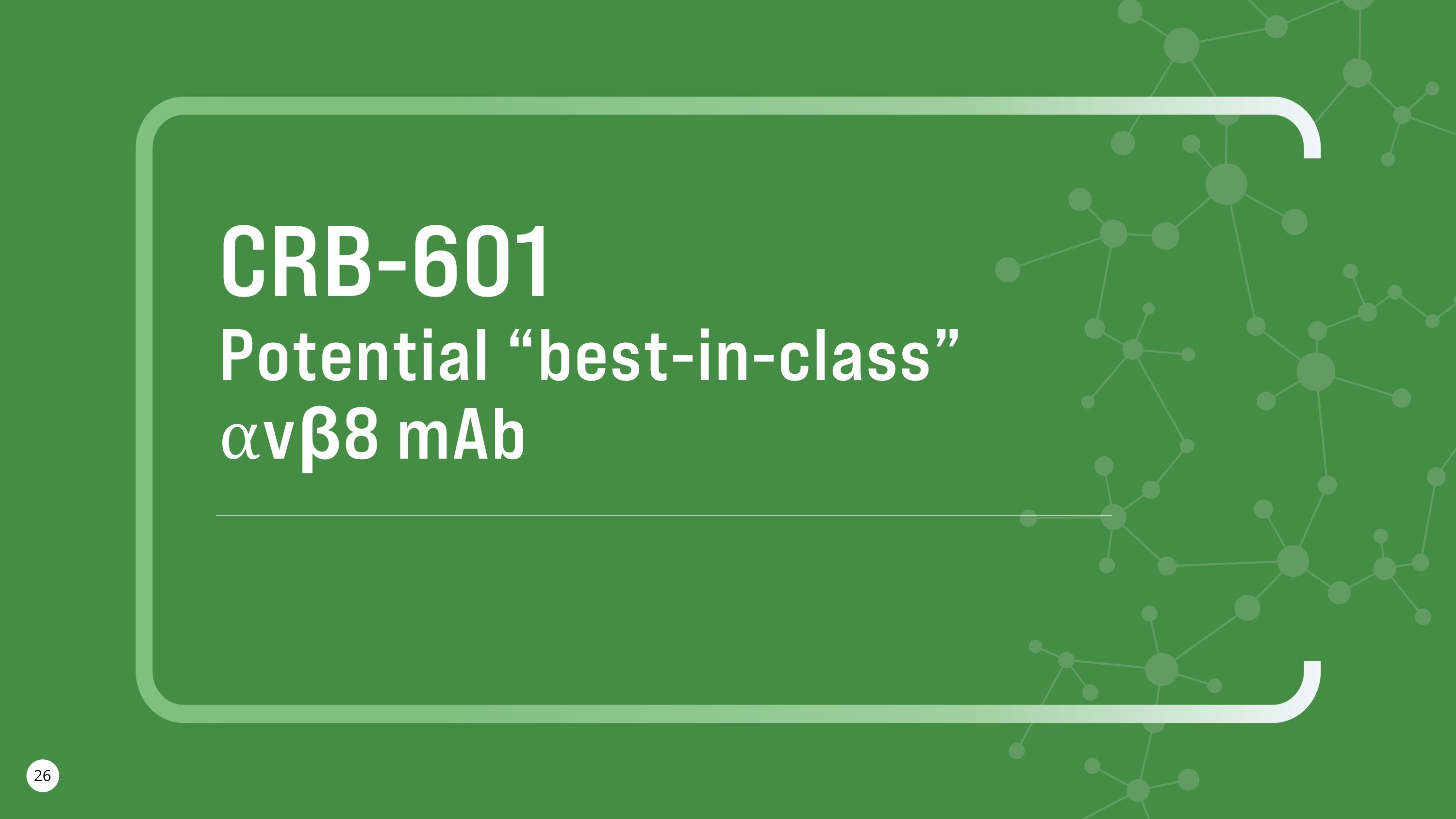
CRB-601 Potential “best-in-class” ⍺vβ8 mAb
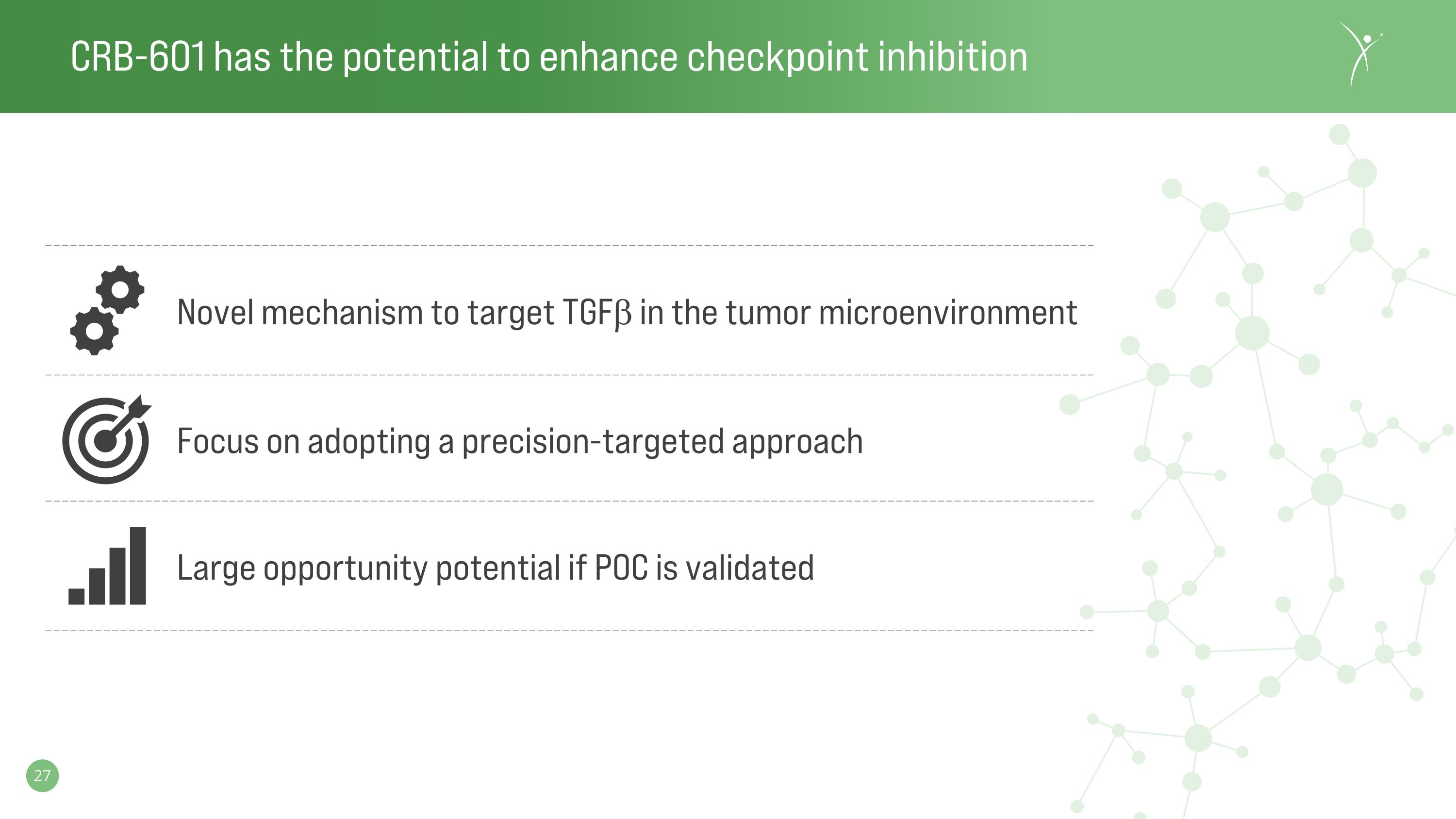
CRB-601 has the potential to enhance checkpoint inhibition Focus on adopting a precision-targeted approach Novel mechanism to target TGFb in the tumor microenvironment Large opportunity potential if POC is validated
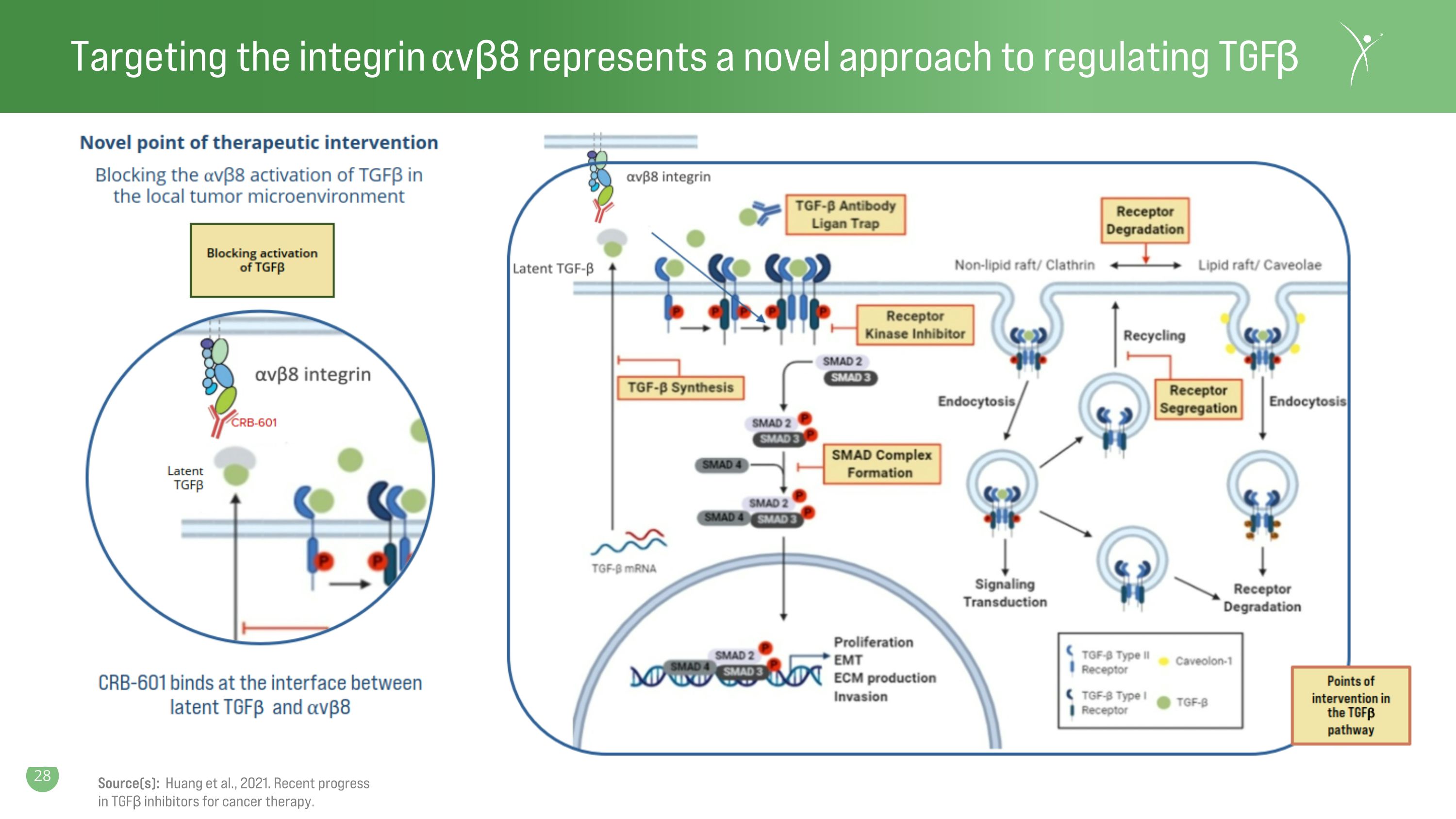
Targeting the integrin ⍺vβ8 represents a novel approach to regulating TGFβ Source(s): Huang et al., 2021. Recent progress in TGFβ inhibitors for cancer therapy.
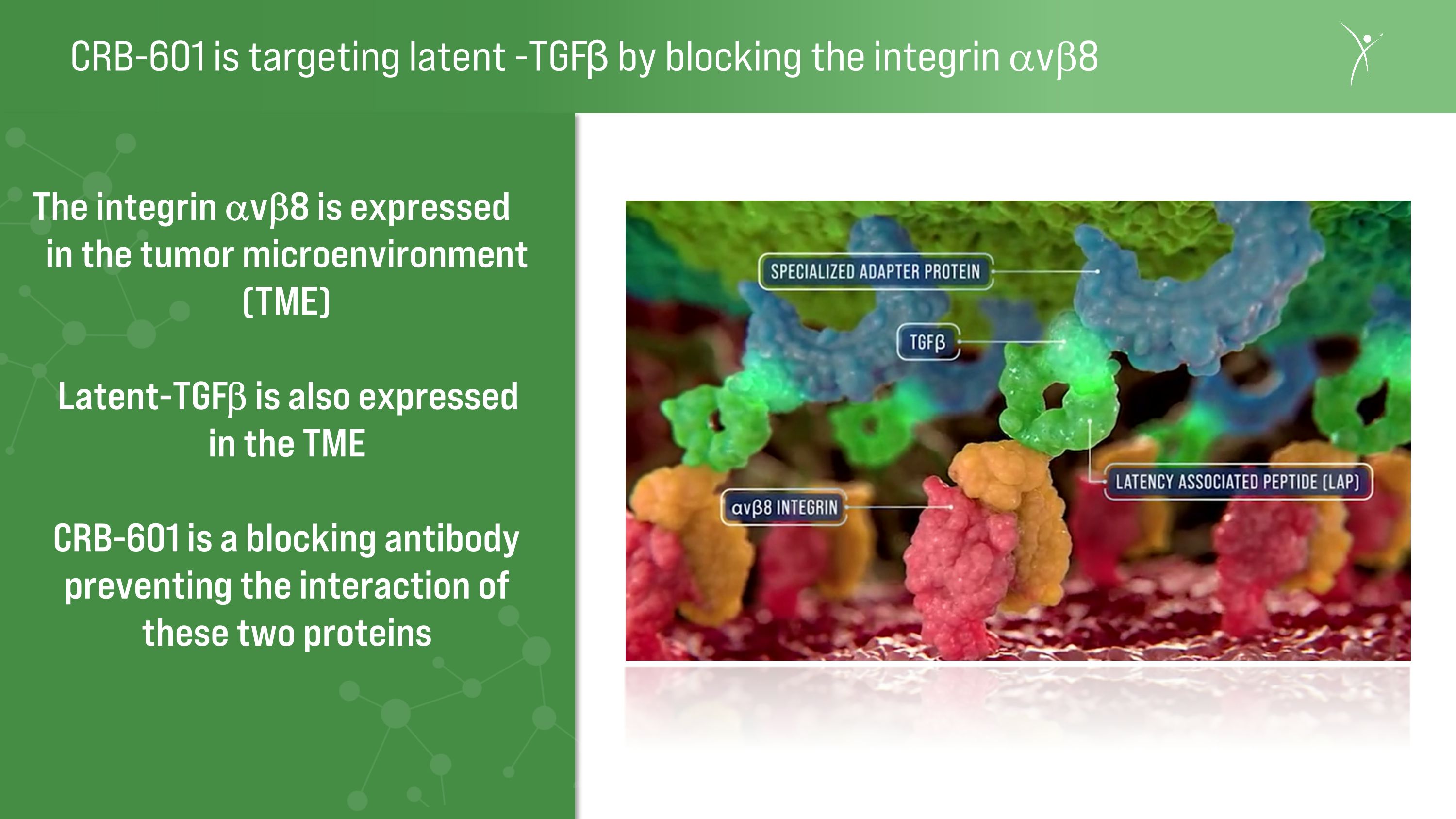
CRB-601 is targeting latent -TGFβ by blocking the integrin avb8 The integrin avb8 is expressed in the tumor microenvironment (TME) Latent-TGFb is also expressed in the TME CRB-601 is a blocking antibody preventing the interaction of these two proteins
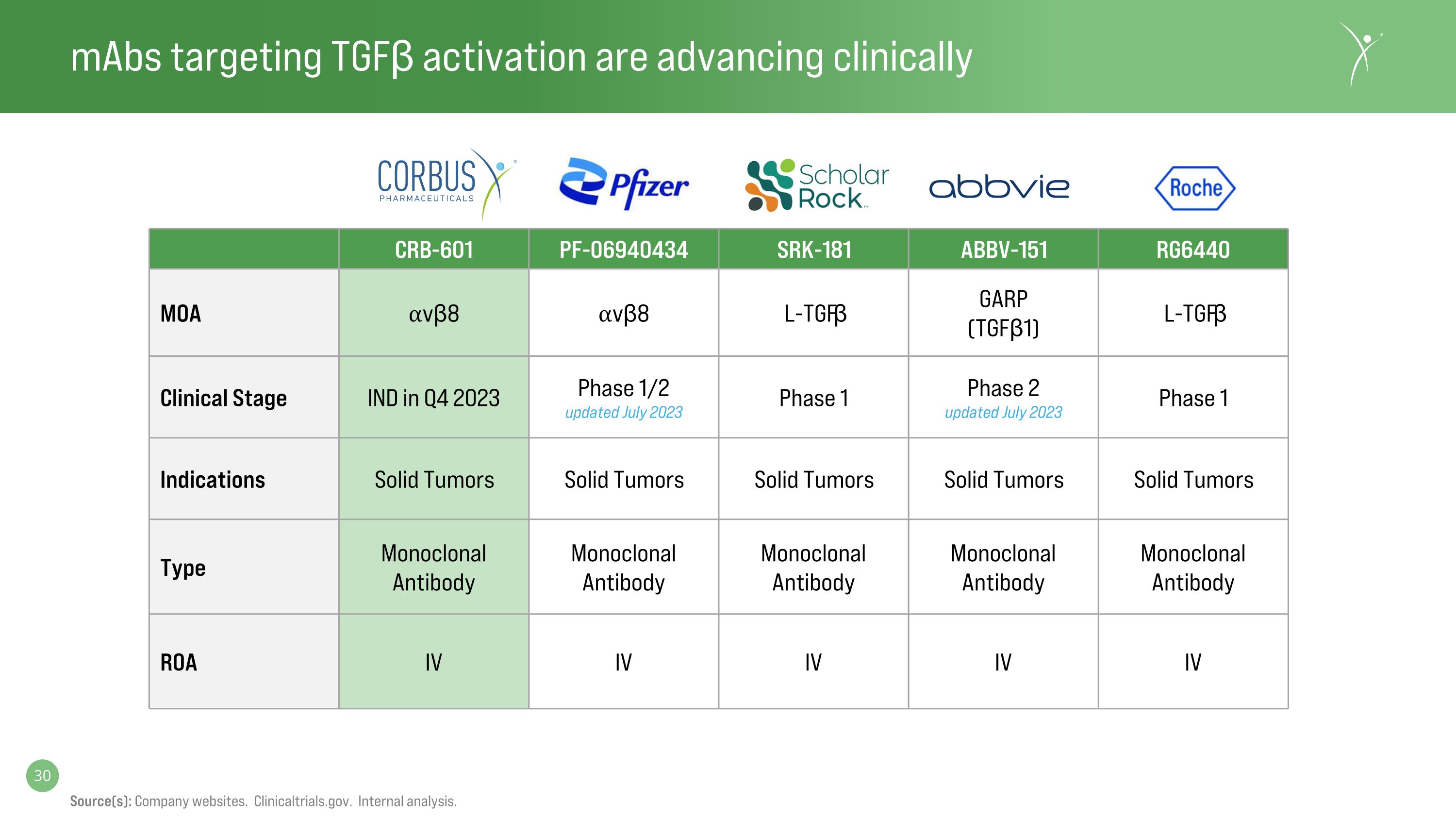
mAbs targeting TGFβ activation are advancing clinically Source(s): Company websites. Clinicaltrials.gov. Internal analysis. CRB-601 PF-06940434 SRK-181 ABBV-151 RG6440 MOA ⍺vβ8 ⍺vβ8 L-TGFβ GARP (TGFβ1) L-TGFβ Clinical Stage IND in Q4 2023 Phase 1/2 updated July 2023 Phase 1 Phase 2 updated July 2023 Phase 1 Indications Solid Tumors Solid Tumors Solid Tumors Solid Tumors Solid Tumors Type Monoclonal Antibody Monoclonal Antibody Monoclonal Antibody Monoclonal Antibody Monoclonal Antibody ROA IV IV IV IV IV
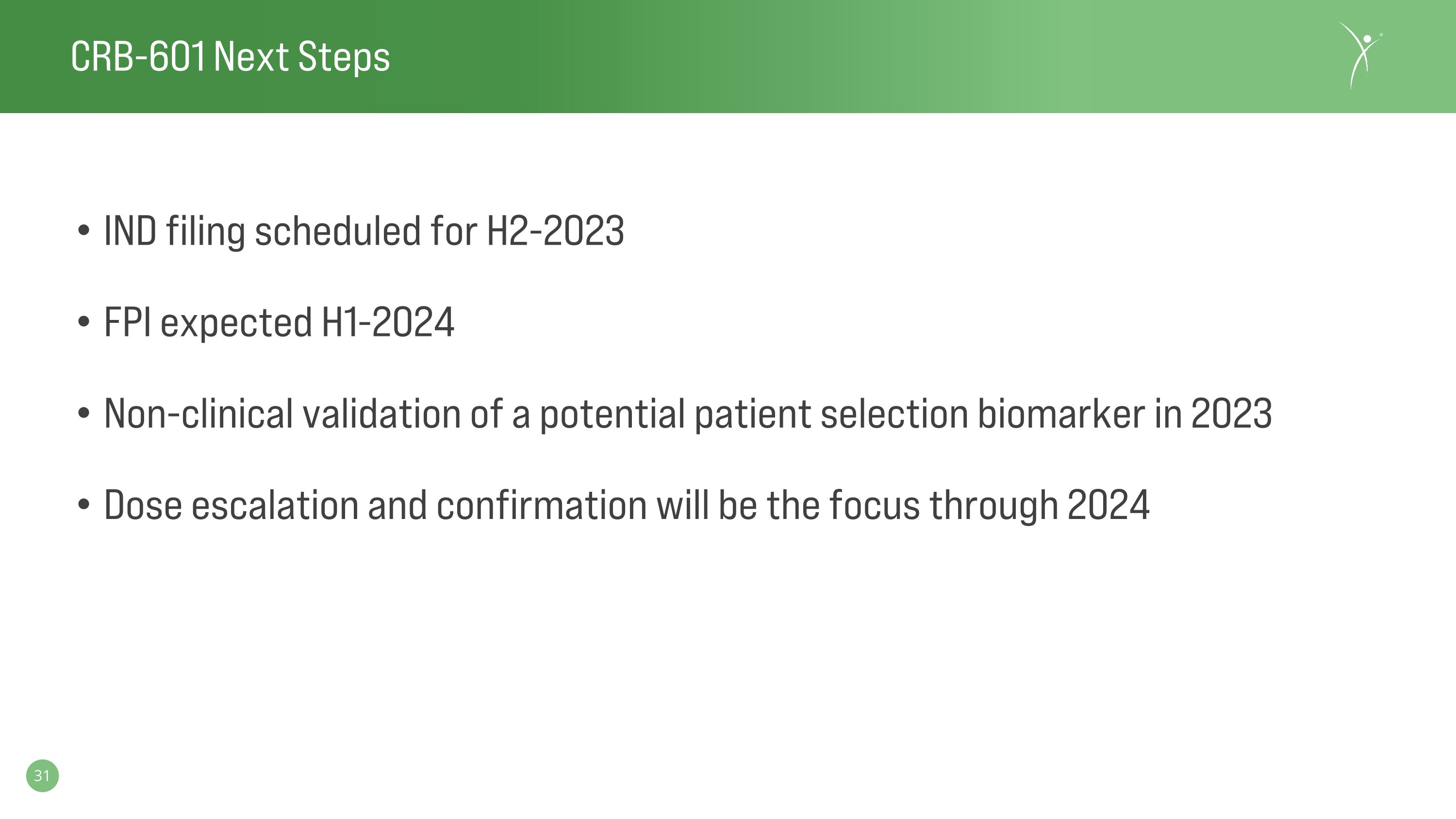
CRB-601 Next Steps IND filing scheduled for H2-2023 FPI expected H1-2024 Non-clinical validation of a potential patient selection biomarker in 2023 Dose escalation and confirmation will be the focus through 2024

Upcoming catalysts Leadership Financials
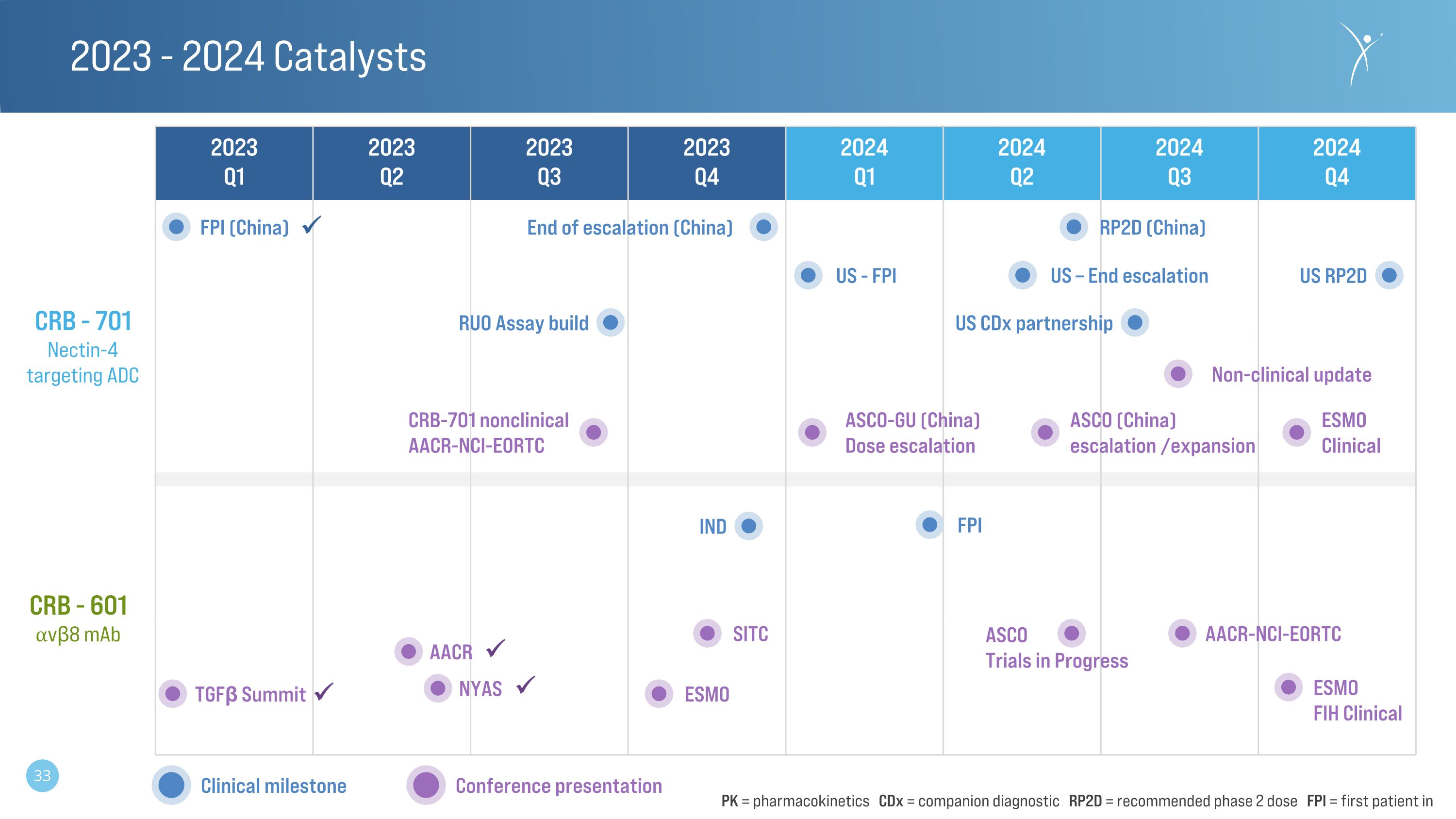
2023 - 2024 Catalysts 2023 Q1 2023 Q2 2023 Q3 2023 Q4 2024 Q1 2024 Q2 2024 Q3 2024 Q4 CRB - 601 ⍺vβ8 mAb CRB - 701 Nectin-4 targeting ADC IND FPI AACR-NCI-EORTC TGFβ Summit NYAS ESMO ASCO Trials in Progress Conference presentation Clinical milestone SITC PK = pharmacokinetics CDx = companion diagnostic RP2D = recommended phase 2 dose FPI = first patient in AACR ESMO FIH Clinical US CDx partnership CRB-701 nonclinical AACR-NCI-EORTC Non-clinical update ASCO (China) escalation /expansion FPI (China) RP2D (China) End of escalation (China) ASCO-GU (China) Dose escalation US - FPI US – End escalation US RP2D RUO Assay build ESMO Clinical

Management Team Yuval Cohen, PhD Chief Executive Officer, Director Corbus co-founder and Chief Executive Officer since 2014. Previously the President and co-founder of Celsus Therapeutics from 2005 Sean Moran, CPA, MBA Chief Financial Officer Corbus co-founder and Chief Financial Officer since 2014. Prior senior financial management experience in emerging biotech and medical device companies. Rachael Brake, PhD Chief Scientific Officer Expert in developing and executing innovative drug discovery and clinical development oncology programs at several leading pharmaceutical companies Christina Bertsch Head of Human Resources Accomplished senior human resource executive providing strategic HR consulting services to both large and small businesses across a variety of industries

Board of Directors Amb. Alan Holmer Ret. Chairman of the Board More than two decades of public service in Washington, D.C. including Special Envoy to China; Former CEO of PhRMA Avery W. (Chip) Catlin Director More than 25 years of senior financial leadership experience in life science companies; Former CFO and Secretary of Celldex Therapeutics Yuval Cohen, PhD Chief Executive Officer, Director Corbus co-founder and Chief Executive Officer since 2014. Previously the President and co-founder of Celsus Therapeutics from 2005 Rachelle Jacques Director More than 25-year professional career, experience in U.S. and global biopharmaceutical commercial leadership, including multiple high-profile product launches in rare diseases; CEO of Akari Therapeutics (NASDAQ: AKTX) John K. Jenkins, MD Director Distinguished 25-year career serving at the U.S. FDA, including 15 years of senior leadership in CDER and OND Pete Salzmann, MD, MBA Director 20 years of industry experience and currently serves as Chief Executive Officer of Immunovant (NASDAQ: IMVT), a biopharmaceutical company focused on developing therapies for patients with autoimmune diseases Anne Altmeyer, PhD, MBA, MPH Director 20 years of experience advancing oncology R&D programs and leading impactful corporate development transactions; currently President & CEO of TigaTx Yong (Ben) Ben, MD, MBA Director 25 years of oncology R&D experience across industry and academia. Held two industry CMO positions, most recently at BeiGene (BGNE).

Investment Summary Advancing anti-⍺vβ8 integrin program to IND submission in Q4-2023 Engaging in business development activities to expand Corbus oncology pipeline Sufficient capital to fund operations through the second quarter of 2024 CRBP Ticker $37 Million Focus on developing precision oncology + differentiated assets Clinically developing a next generation Nectin-4 targeting ADC 1. Reflects 1 for 30 reverse stock split effective Feb 14, 2023 Cash and investments as of June 30, ,2023 4.4 M Common Shares Outstanding (5.2M Fully Diluted Shares) 1

Appendix

CRB-701 is licenced from CSPC1: a top ten biopharmaceutical company in China2 HKSE: 1093.HK Market Cap: $10.8B3 2022 Revenue: $4.3B3 # of employees: 24,837 864 drug licenses, 68 API licenses ~300 R&D projects under development, First approval in China for mRNA covid vaccine Therapeutic out licensing: Elevation (EO-3021) Flame (FL-301) Source(s): 1. US and European commercialization rights in-licensed from CSPC Megalith Biopharmaceutical Co., Lt. (China), a subsidiary of CSPC Pharmaceutical Group 2. GlobalData as of Dec 31, 2022. 3. Yahoo Finance as of July 28, 2023. Company websites. CSPC data on file. Recent US deals: Pfizer (Paxlovid)

TGFβ predicts poor clinical outcomes in a subset of cancer patients 0 25 20 15 10 5 0.0 0.2 0.4 0.6 0.8 1.0 N = 8,461 cancers, multiple cell types Time (years) Overall survival, % Immunogenomic subtypes in cancer Source(s): Thorsson, et al. The Immune Landscape of Cancer, Immunity. 2018; 48:817 C1 C2 C3 C4 C5 C6 WOUND HEALING INF-γ DOMINANT INFLAMMATORY LYMPHOCYTE DEPLETED IMMUNOLOGICALLY QUIET TGFβ DOMINANT TGFβ predominance gene signature Gene expression, immune cell quantification & network mapping 33 different cancer types / 8,000+ tumors
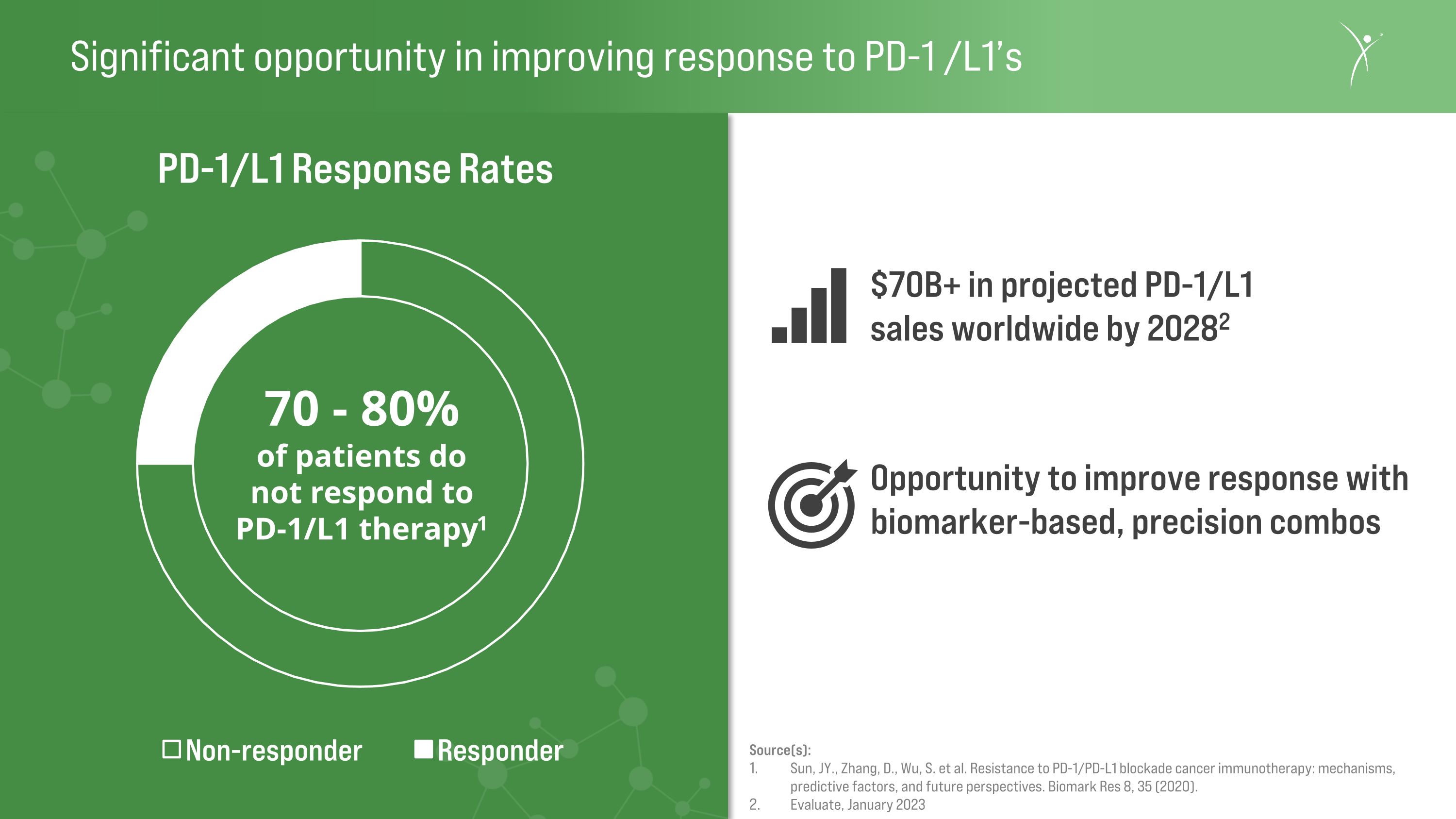
Significant opportunity in improving response to PD-1 /L1’s 70 - 80% of patients do not respond to PD-1/L1 therapy1 $70B+ in projected PD-1/L1 sales worldwide by 20282 Opportunity to improve response with biomarker-based, precision combos Source(s): Sun, JY., Zhang, D., Wu, S. et al. Resistance to PD-1/PD-L1 blockade cancer immunotherapy: mechanisms, predictive factors, and future perspectives. Biomark Res 8, 35 (2020). Evaluate, January 2023
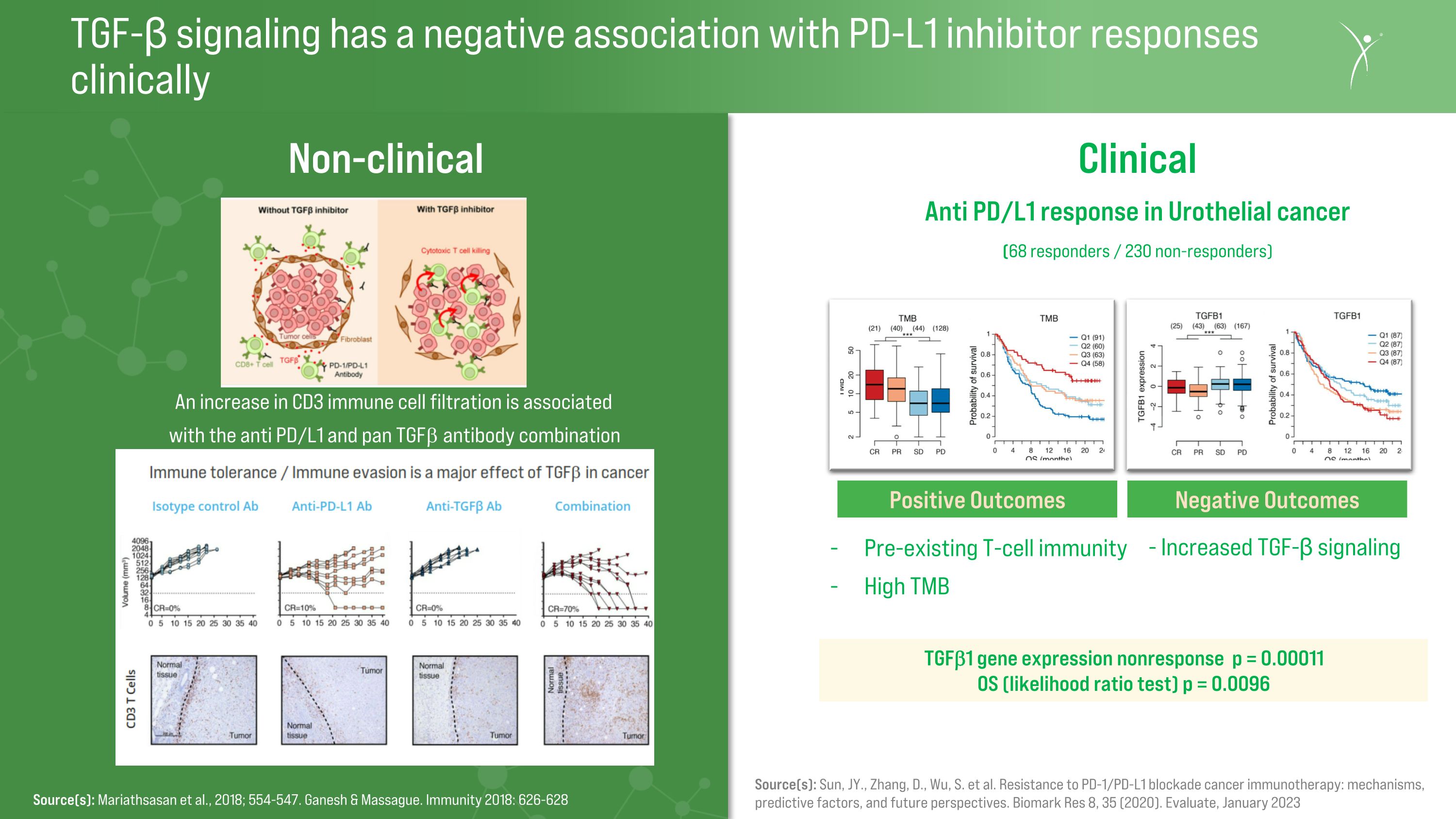
TGF-β signaling has a negative association with PD-L1 inhibitor responses clinically Source(s): Sun, JY., Zhang, D., Wu, S. et al. Resistance to PD-1/PD-L1 blockade cancer immunotherapy: mechanisms, predictive factors, and future perspectives. Biomark Res 8, 35 (2020). Evaluate, January 2023 Clinical Anti PD/L1 response in Urothelial cancer (68 responders / 230 non-responders) Positive Outcomes Negative Outcomes Pre-existing T-cell immunity High TMB - Increased TGF-β signaling TGFb1 gene expression nonresponse p = 0.00011 OS (likelihood ratio test) p = 0.0096 Non-clinical Source(s): Mariathsasan et al., 2018; 554-547. Ganesh & Massague. Immunity 2018: 626-628 An increase in CD3 immune cell filtration is associated with the anti PD/L1 and pan TGFb antibody combination
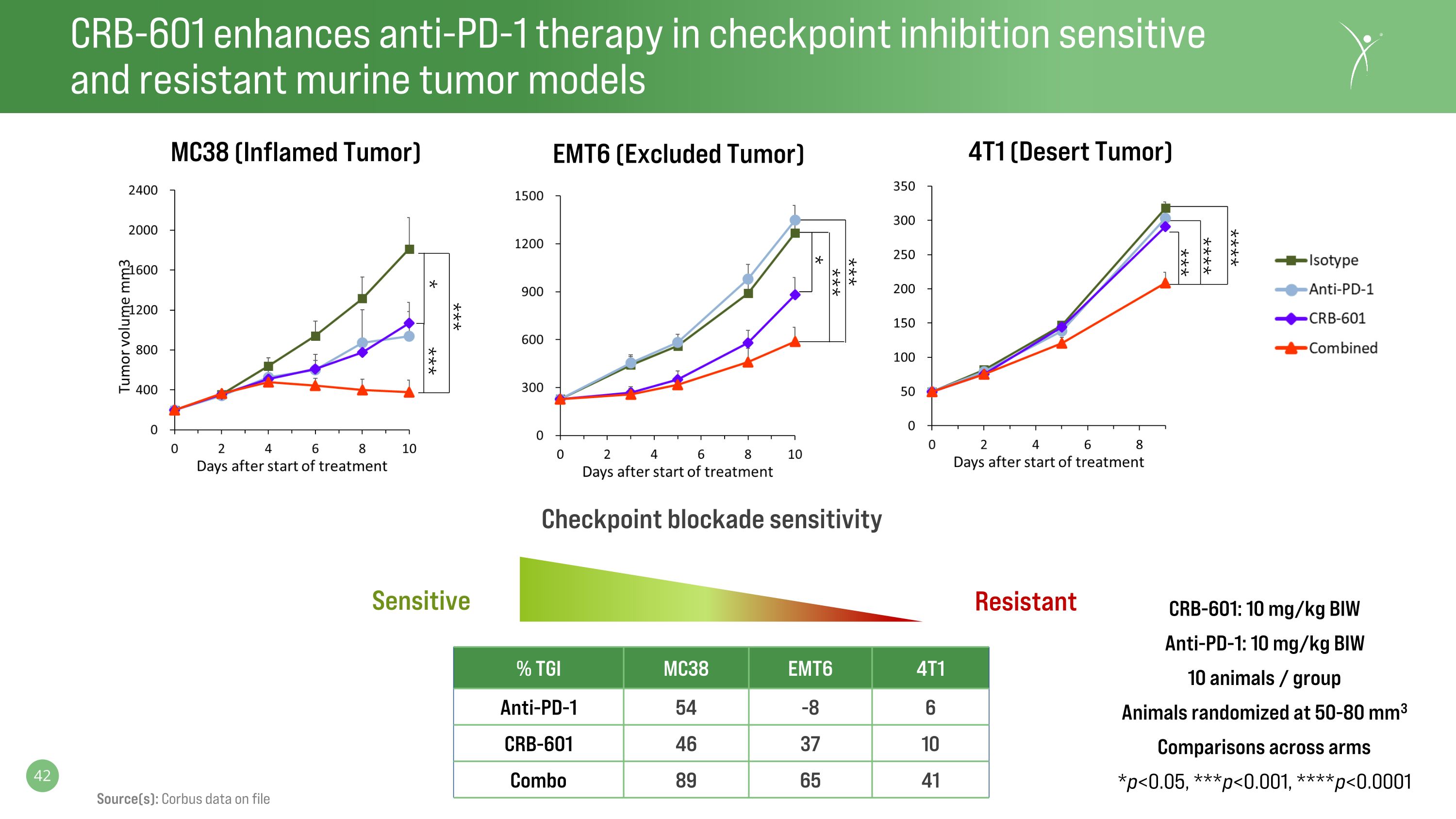
CRB-601 enhances anti-PD-1 therapy in checkpoint inhibition sensitive and resistant murine tumor models CRB-601: 10 mg/kg BIW Anti-PD-1: 10 mg/kg BIW 10 animals / group Animals randomized at 50-80 mm3 Comparisons across arms *p<0.05, ***p<0.001, ****p<0.0001 % TGI MC38 EMT6 4T1 Anti-PD-1 54 -8 6 CRB-601 46 37 10 Combo 89 65 41 Resistant Checkpoint blockade sensitivity Sensitive MC38 (Inflamed Tumor) EMT6 (Excluded Tumor) 4T1 (Desert Tumor) *** **** **** *** * *** *** *** * Source(s): Corbus data on file

Blockade of ⍺vβ8 in combination with anti-PD-1 increased TIL populations in immune excluded EMT6 tumors **** *** **** **** **** *** **** **** Ki67+CD4 T Cells Ki67+CD8 T Cells CD4 T Cells CD8 T Cells Tumor Size * *** * **** ** *** ** *** ** **** * **** * Treatment Days -14 0 3 6 10 Anti-PD-1, 10 mg/kg, IP CRB-601, 30 mg/kg, IP EMT6 orthotopic implantation PD readouts Tumor volume = 200 mm3 (when treatment initiated) *p<0.05; **p<0.01; ***p<0.001; ****p<0.0001 M1/M2 Ratio NK Cells ** ** **** **** * * Source(s): Corbus data on file
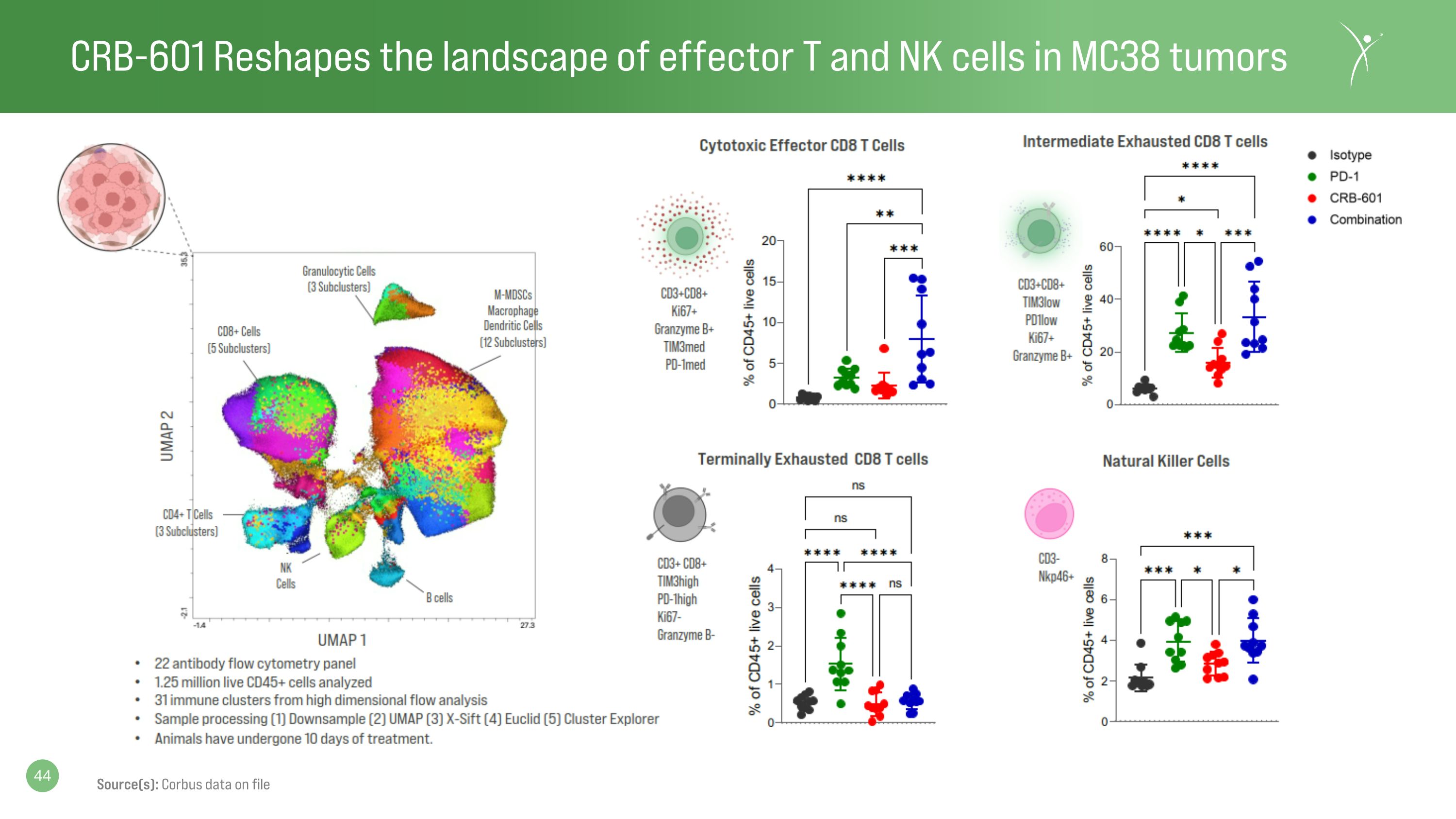
CRB-601 Reshapes the landscape of effector T and NK cells in MC38 tumors Source(s): Corbus data on file
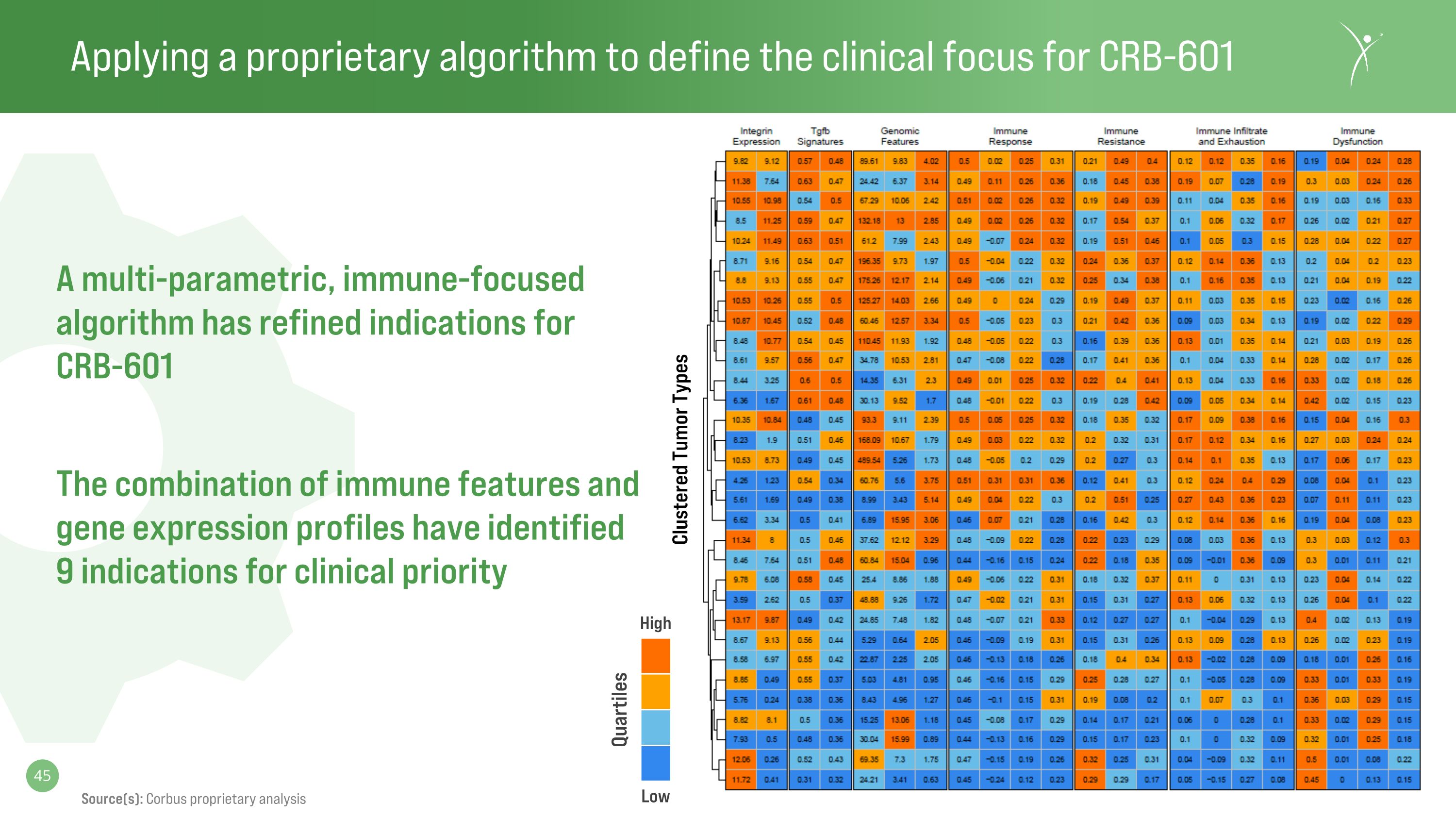
Applying a proprietary algorithm to define the clinical focus for CRB-601 A multi-parametric, immune-focused algorithm has refined indications for CRB-601 The combination of immune features and gene expression profiles have identified 9 indications for clinical priority High Low Quartiles Source(s): Corbus proprietary analysis Clustered Tumor Types
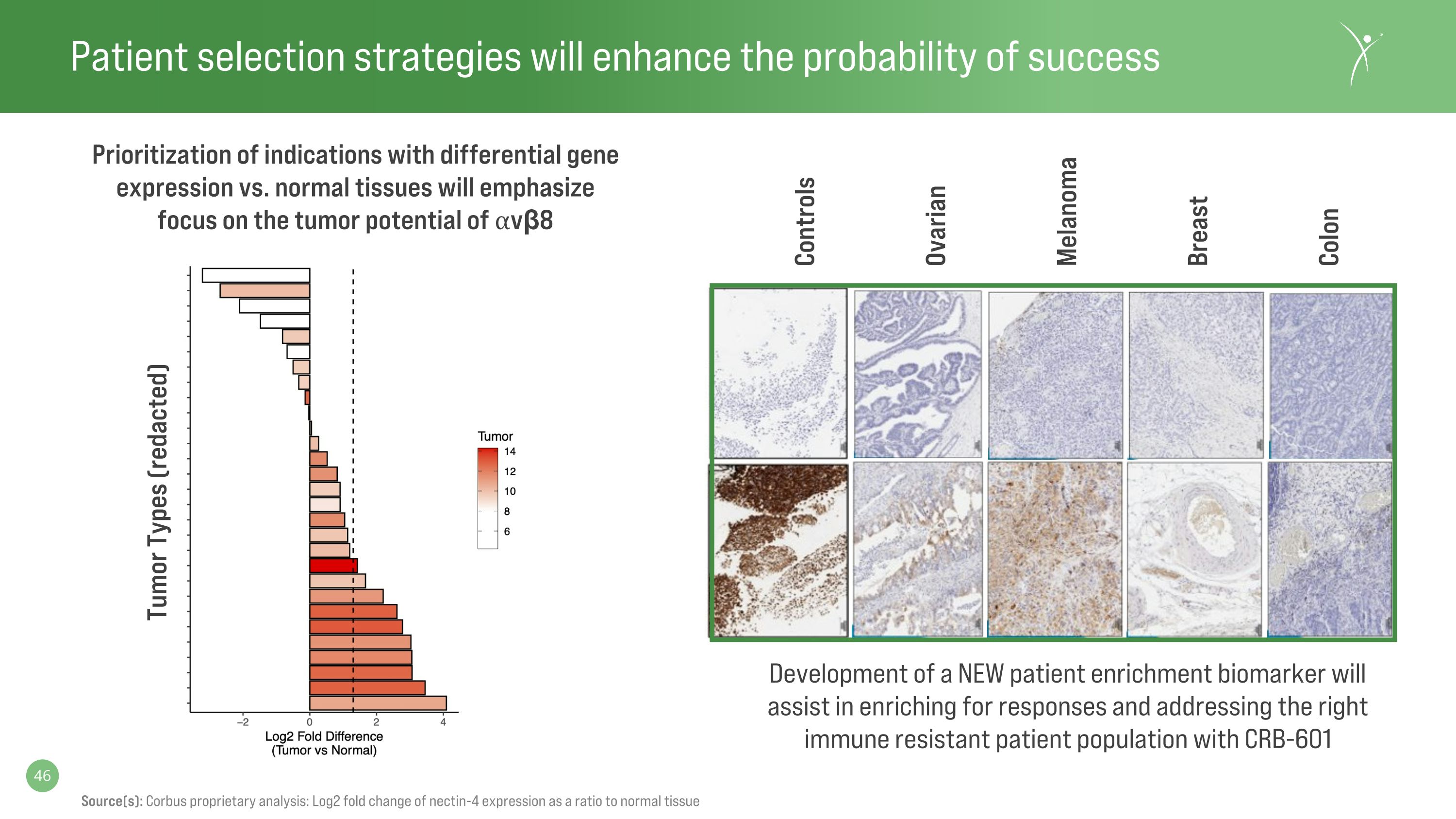
Patient selection strategies will enhance the probability of success Source(s): Corbus proprietary analysis: Log2 fold change of nectin-4 expression as a ratio to normal tissue Controls Ovarian Melanoma Breast Colon Prioritization of indications with differential gene expression vs. normal tissues will emphasize focus on the tumor potential of ⍺vβ8 Development of a NEW patient enrichment biomarker will assist in enriching for responses and addressing the right immune resistant patient population with CRB-601 Tumor Types (redacted)